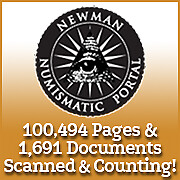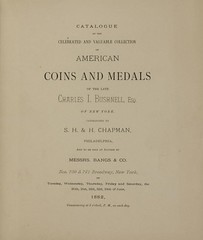
About UsThe Numismatic Bibliomania Society is a non-profit organization devoted to the study and enjoyment of numismatic literature. For more information please see our web site at coinbooks.org SubscriptionsThose wishing to become new E-Sylum subscribers (or wishing to Unsubscribe) can go to the following web page link MembershipThere is a membership application available on the web site Membership Application To join, print the application and return it with your check to the address printed on the application. Membership is only $20 to addresses in the U.S., $25 for First Class mail, and $30 elsewhere. For those without web access, write to: Terry White, Treasurer
AsylumFor Asylum mailing address changes and other membership questions, contact Terry at this email address: terrywhite5475@yahoo.com SubmissionsTo submit items for publication in The E-Sylum, just Reply to this message, or write to the Editor at this address: whomren@gmail.com BUY THE BOOK BEFORE THE COINSale Calendar |
- WAYNE'S WORDS: THE E-SYLUM JANUARY 17, 2016
- BRYCE BROWN MAIL BID SALE #2 CLOSES MARCH 5TH, 2016
- LAKE BOOKS 124TH SALE DELAYED TO MARCH 15, 2016
- NEW BOOK: TRUTH SEEKER: THE LIFE OF ERIC P. NEWMAN
- NEW BOOK: ENCYCLOPEDIA OF OBSOLETE PAPER MONEY, VOL. 6
- ARTICLE PROFILES LITERATURE DEALER DAVID FANNING
- CHATEAU D’HAUTEVILLE LIBRARY SELECTIONS OFFERED
- NEWMAN PORTAL DIGITIZES ANS COAC PROCEEDINGS
- THE ANS POLICY ON OPEN ACCESS TO PUBLICATIONS
- DIANA HERZOG 1939-2016
- VIDEO: REDISCOVERY OF THE WALTON 1913 LIBERTY NICKEL
- DICK JOHNSON'S TOPICAL BIBLIOGRAPHY
- NOTES FROM E-SYLUM READERS: JANUARY 17, 2016
- 1929 FRENCH FOREIGN OFFICE MEDAL INFO SOUGHT
- CHAPMAN BUSHNELL SALE LOT #1668 BUYER SOUGHT
- LOTTERIES IN COLONIAL AMERICA
- WOODEN MONEY COLLECTORS EXPAND MEMBERSHIP
- SKYLAB PLASTER MODELS FROM SCULPTOR'S ESTATE
- COIN TELEMARKETING PIONEER STANLEY APFELBAUM
- HIRAM EDMUND DEATS (1870-1963)
- SELECTIONS FROM DAVISSON'S AUCTION 35
- INDIAN MINISTER PROPOSES LAW AGAINST MELTING ANCIENT COINS
- ANS GALA: THE ‘ACADEMY AWARDS’ OF COIN COLLECTING
- WAYNE’S NUMISMATIC DIARY: JANUARY 17, 2016
- THE BRITISH VIEW OF COINS AS INVESTMENTS
- CANADIAN COIN COMMEMORATES TRANSATLANTIC CABLE
- SPELLING ERRORS ON COINS
- RUSSIA ISSUES A ‘CREDIT CARD’ COIN
- CANADA'S POLYMER NOTES THWARTING COUNTERFEITERS
- FANS WANT DAVID BOWIE ON A U.K. BANKNOTE
- ARGENTINA TO ISSUE HIGHER DENOMINATION BANKNOTES
- BANKS REFUSE TO HANDLE CHINESE MAN'S COIN STASH
- CHINESE MAN BUYS CAR WITH LOW-VALUE BANKNOTE HOARD
- CHINESE MAN SHREDS $21,000 IN BANKNOTES
- FEATURED WEB SITE: CENTRAL STATES NUMISMATIC SOCIETY
Click here to access the complete archive
To comment or submit articles, reply to whomren@gmail.com
WAYNE'S WORDS: THE E-SYLUM JANUARY 17, 2016

New subscribers this week include: Robert Hoppensteadt. We now have 1,924 subscribers.
This week we open with updates from numismatic literature dealers Bryce Brown and Fred Lake, two new books and an article profiling David Fanning.
Other topics include the ANS COAC Proceedings, the Walton 1913 Liberty Nickel, lotteries in Colonial America, Stanley Apfelbaum, Diana Herzog, Hiram Deats, the 2016 ANS Gala, spelling errors on coins, credit cards, and China's cash hoards.
To learn more about obsolete paper money, Open Access, Wooden Money, Skylab medals and plasters, the Swiatek-Breen commemorative book, the Ormond Siege Sixpence, the Oreo Triathalon medal and the 'Academy Awards' of coin collecting, read on. Have a great week, everyone!
Wayne Homren
Editor, The E-Sylum
BRYCE BROWN MAIL BID SALE #2 CLOSES MARCH 5TH, 2016
Bryce Brown’s Numismatic Literature Auctions will be holding their 2nd mail-bid sale of important numismatic literature, which will close on Saturday, March 5th, 2016. The sale will feature American, Ancient and Foreign material from the libraries of several prominent numismatists. The sale catalog is expected to be published around February 8th. Anybody seeking to submit a last-minute consignment should contact Bryce immediately at numismatics@att.net. Phone: 860-751-2555; Fax: 203-900-0249
For more information about Bryce Brown’s Numismatic Literature Auctions, see:
http://www.bbnla.com/
LAKE BOOKS 124TH SALE DELAYED TO MARCH 15, 2016
In my capacity as a member of the Board of Directors of the Florida United Numismatists (FUN), I perform several functions that require me to use a four-wheel “scooter” in order to get to a number of locations at the FUN Convention practically at the same time, etc. , and this would include, for instance, to take photographs.
I had a mishap on Thursday, January 7th that caused me to accidentally drive backwards off a four-step staircase. This careless act caused me to incur several broken ribs putting me into the hospital. I was there until I arrived home on January 10th. Because of all this, we have decided to postpone our sale #124, originally scheduled for Feb. 9, 2016, to now have a closing date of March 15, 2016.
The links for the sale will now be opened on Feb. 9th. Notice will be given in February for you to open the catalog then. Those of you who receive a printed catalog should write the new closing date of March 15, 2016 into that catalog. I am now resting comfortably at home and expect to be quite ready for the new sale date. Cordially, Fred
Lake Books
6822 22nd Ave N
St. Petersburg, FL 33710-3918
727-343-8055 fax: 727-381-6822
THE BOOK BAZARRE
NEW BOOK: TRUTH SEEKER: THE LIFE OF ERIC P. NEWMAN
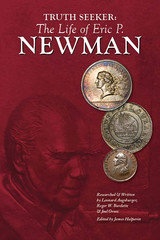 Truth Seeker: The Life of Eric P. Newman
Truth Seeker: The Life of Eric P. Newman
Researched & Written by Leonard Augsburger, Roger W. Burdette & Joel Orosz
Edited by James Halperin
A powerful and intimidating dealer of the 1960s, backed by important colleagues, was accused of selling fraudulent gold coins and ingots to unsuspecting numismatists. Who would go up against a man like that and, over the course of decades, prove the fraud? Who would expose a widely respected scholar as a thief, then doggedly pursue recovery of coins that the scholar had stolen from an embarrassed numismatic organization, all over the objections of influential collectors who had bought coins with clouded titles?
Eric P. Newman would - and did.
Researched, written and edited by titans in the numismatic field, Truth Seeker: The Life of Eric P. Newman, is an expansive biography. The book comprises 400+ pages of memorable stories suffused with fascinating illustrations and documents, all chronicling the admirable life of Newman, now 104 years young. In 43 chapters, Truth Seeker traces Newman's world-class collection from its inspiration - when his grandfather gave him an 1859 Indian head copper-nickel cent - to explaining the theory behind Newman's favorite coin. The history and content of his renowned and unparalleled collection, which he donated to charitable causes, would alone have been more than enough to fill the pages. Yet this work also profiles those who influenced him, both allies and adversaries, alongside the intellect, ethics, drive, and eternal optimism of a highly accomplished philanthropist who led his beloved hobby out of its own dark ages.
For more information, or to order, see:
Truth Seeker: The Life of Eric P.
Newman (http://coins.ha.com/itm/books/truth-seeker-the-life-of-eric-p-newmanres/i/960011799.s)
To read the earlier E-Sylum article, see:
NEW BOOK: TRUTH SEEKER: THE LIFE OF ERIC P. NEWMAN
(www.coinbooks.org/esylum_v19n01a04.html)
NEW BOOK: ENCYCLOPEDIA OF OBSOLETE PAPER MONEY, VOL. 6
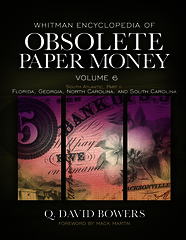 Whitman Publishing announces the release of volume 6 of the Whitman Encyclopedia of Obsolete Paper Money, by Q. David Bowers. In 496
pages it covers the early bank currency of the states of Florida, Georgia, North Carolina, and South Carolina. The book debuted at the FUN (Florida
United Numismatists) show in January 2016, and now can be ordered from booksellers and hobby shops nationwide and online (including at
www.Whitman.com), for $69.95. It can also be borrowed for free as a benefit of membership in the American Numismatic Association, through the Dwight
N. Manley Numismatic Library.
Whitman Publishing announces the release of volume 6 of the Whitman Encyclopedia of Obsolete Paper Money, by Q. David Bowers. In 496
pages it covers the early bank currency of the states of Florida, Georgia, North Carolina, and South Carolina. The book debuted at the FUN (Florida
United Numismatists) show in January 2016, and now can be ordered from booksellers and hobby shops nationwide and online (including at
www.Whitman.com), for $69.95. It can also be borrowed for free as a benefit of membership in the American Numismatic Association, through the Dwight
N. Manley Numismatic Library.
The Whitman Encyclopedia of Obsolete Paper Money is a multiple-volume study of currency issued from 1782 to 1866, before the modern era of National Banks and the Federal Reserve. Over the course of these decades more than 3,000 state-chartered banks issued their own paper money, which facilitated much of the nation’s day-to-day commerce.
In volume 6, Bowers, a well-known historian and past president of the American Numismatic Association, gives the history of 87 Florida, Georgia, North Carolina, and South Carolina towns and cities, as well as of every bank in those towns that issued this uniquely American currency. Each note is studied, and hundreds are pictured in full color, with information on grading, rarity, values, significant auction results, advice for collectors, and more.
“Many old Southern bank notes are out there, waiting to be discovered and identified,” says Bowers. “There are rare bills worth hundreds and even thousands of dollars. At the same time, bargains abound in the marketplace, and a smart collector can build a beautiful set of historical Southern notes very affordably.”
Active collectors, researchers, dealers, historians, and other experts have volunteered their time and knowledge to help create this new encyclopedia series. The state editors are Southern States specialists Ronald Benice, Alan Dorris, Paul Horner, and Jerry Roughton. Mack Martin, a paper-money expert and award-winning exhibitor of Georgia obsolete notes, wrote the foreword to volume 6. “There has been a great deal of research done on Georgia obsolete currency over the years, but there were so many issuing agencies and so many different notes that for a long time no one was able to bring all of the information together and publish a comprehensive tome on the subject,” Martin says. “But Dave Bowers has remedied all this with the magnificent new Whitman Encyclopedia of Obsolete Paper Money. This book must be in the library of any collector of obsolete currency.”
Whitman Senior Associate Editor Caitlyn Trautwein says, “Until now, the histories of these Southern towns and banks have not been presented in a way that is accessible for collectors. Volume 6 of the Whitman Encyclopedia changes that, as the histories have been compiled from dozens of primary and secondary sources and collated into a single invaluable resource.”
Earlier volumes of the Whitman Encyclopedia of Obsolete Paper Money include an overview of the field, and detailed coverage of the New England states of Connecticut, Maine, New Hampshire, Massachusetts, Rhode Island, and Vermont. Future volumes will cover the rest of the South Atlantic states, plus the Mid-Atlantic states, the American Midwest, the District of Columbia, and territories.
Collectors, dealers, historians, and hobbyists interested in assisting on future volumes may contact Whitman Publishing at Obsoletes@Whitman.com.
Whitman Encyclopedia of Obsolete Paper Money
Volume 6: South Atlantic, Part 1—Florida, Georgia, North Carolina, and South Carolina
By Q. David Bowers; edited by Ronald Benice, Alan Dorris, Paul Horner, and Jerry Roughton; foreword by Mack Martin
ISBN 0794843409
Hardcover, 8.5 x 11 inches, 496 pages
Full color
Retail $69.95 U.S.
For more information, or to order, see:
Whitman
Encyclopedia of Obsolete Paper Money, Volume 6
(www.whitman.com/store/Inventory/Detail/Whitman-Encyclopedia-of-Obsolete-Paper-Money-Volume-6+0794843409)
To read the earlier E-Sylum articles, see:
WHITMAN OBSOLETE PAPER MONEY ENCYCLOPEDIA SELLS OUT
(www.coinbooks.org/esylum_v17n30a02.html) NEW BOOKS : ENCYCLOPEDIA OF OBSOLETE
PAPER MONEY, VOLS 3 & 4 (www.coinbooks.org/esylum_v17n44a03.html) NEW BOOK:
ENCYCLOPEDIA OF OBSOLETE PAPER MONEY, VOL. 5 (www.coinbooks.org/esylum_v18n12a03.html)

ARTICLE PROFILES LITERATURE DEALER DAVID FANNING
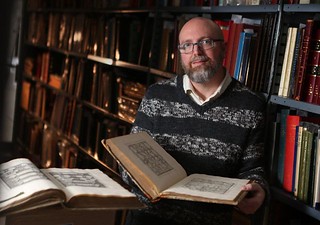 David Fanning makes a living in the niche market of a niche market.
David Fanning makes a living in the niche market of a niche market.
He’s one-half of Kolbe & Fanning, a Gahanna firm that calls itself the world’s largest dealer of rare and out-of-print numismatic literature. In other words, it sells old books about old coins.
“There really are only five or six individuals in the entire world who can say this is their specialty, this is their full-time business,” said Fanning, 44.
His catalog for a recent auction advertised offerings such as The Numismatic Journal for 1836-1837 and Rare Numismatic Oeuvres of Bartolomeo Borghesi.
“Often to people outside our field, it will seem these books are on the most absurdly narrowly focused, tiny, tiny sliver of history — and someone has written a 500-page book on the subject,” Fanning said.
We spoke just after he’d returned from a big auction in New York, where a copy of a 16th-century coin book, one of the first ever published, had fetched more than $10,000.
Fanning — like a lot of his customers — fell in love with coin literature after first falling in love with coins as a child.
“I found this coin in my dad’s change drawer. It was a 3-cent nickel coin from 1865. . . . Well, I didn’t know what it was at all. So I bought a book to tell me. And it kind of took off from there.”
Fanning started dealing in coin books at age 15 or 16, mostly as a way to make money so he could buy more coins. He drifted away from the hobby in college (he has a doctorate in English literature from Ohio State University) but returned to it after that.
He’d been a customer of George Kolbe, a longtime dealer in numismatic literature who lives in California. After Fanning tried holding a few book sales on his own, Kolbe invited him to become a partner in the business. Kolbe is now semiretired.
The ability to research coin histories online has affected the business to some extent, but many collectors buy books for more than information, Fanning said.
To demonstrate, he picked up a 19th-century German coin book to show off its leather binding, high-quality illustrations and green page edges (19th-century German bookmakers had a thing for green, he explained.)
“This isn’t the standard reference work anymore, but it’s very nicely laid out, very nicely printed. It really is quite charming.”
To read the complete article, see:
Joe
Blundo commentary: Vendor finds money in books about coins
(www.dispatch.com/content/stories/life_and_entertainment/2016/01/17/1-vendor-finds-money-in-books-about-coins.html)
CHATEAU D’HAUTEVILLE LIBRARY SELECTIONS OFFERED
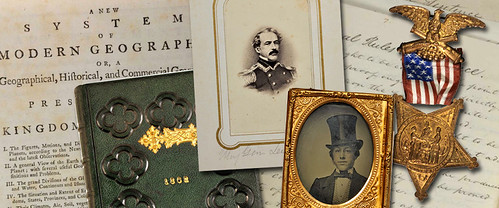
Stack’s Bowers Galleries is pleased to offer several items from the recent sale of the extensive holdings of the Swiss noble family Grand d’Hauteville. The family’s holdings were kept at Chateau d’Hauteville, a castle in the municipality of Saint-Légier-La Chiésaz, Canton Vaud, Switzerland. Included are several important items relating to the career of Alexander Macomb, “The Hero of Plattsburgh,” who in 1828 rose to the position of Commanding General of the United States Army. Macomb’s granddaughter Susan Watts married into the Grand d’Hauteville family, explaining why many of the general’s most important possessions eventually found their way into the holdings of Chateau d’Hauteville.
Macomb’s reputation as an American war hero was solidified with the Battle of Plattsburgh on September 11, 1814, during which he led a force of only 3,400 regular troops and militia to victory over a British force of 10,531 men under the command of Lieutenant General Sir George Prevost. Macomb conducted a successful delaying action, whittling down the British strength and delaying their assault until news arrived of Commodore Thomas Macdonough’s naval victory over the British at the Battle of Lake Champlain. With their naval support destroyed, Prevost’s troops were forced to abandon their planned invasion of the Northern United States – their last of the War – and retreat into Canada. Lauded as “The Hero of Plattsburgh” in the American press, Macomb received the official recognition of the United States government through promotion to major general and receipt of a Congressional gold medal, cataloged today as Julian MI-16 in the standard reference Medals of the United States Mint: The First Century, 1792-1892 by R.W. Julian.
On May 28, 1828, Macomb was appointed Commanding General of the United States Army by President John Quincy Adams, a position he retained until his death on June 25, 1841. During his tenure, he authored a seminal book on the conduct of courts martial and martial law titled The Practice of Courts Martial. Among the highlights of this sale are a handwritten document from the U.S. War Department appointing Macomb Commanding General of the United States Army and Macomb’s original manuscript for his book on courts martial from 1837.
Our offering of selections from the collection of Chateau d’Hauteville also includes other significant items with American themes, such as the Medal of the Order of the Grand Army of the Republic presented to Frederic I. Sears Grand d’Hauteville in 1917, a copy of the book Travel in the Meadows West of the United States by Washington Irving, printed in Paris in 1835, and a remarkable album of more than 150 period cartes de visite of important political and military figures from the American Civil War. Worthy of careful consideration by students of American military history and more generalized Americana collectors alike, these offerings may very well represents a once in a lifetime bidding opportunity.
To read the complete article, see:
Crossing the Block: Selections from the Library of Chateau d’Hauteville (www.stacksbowers.com/NewsMedia/Blogs/TabId/780/
ArtMID/2678/ArticleID/65535/Crossing-the-Block-Selections-
from-the-Library-of-Chateau-d%E2%80%99Hauteville.aspx)
To read the earlier E-Sylum articles, see:
MACOMB BATTLE OF PLATTSBURGH GOLD MEDAL OFFERED
(www.coinbooks.org/esylum_v18n36a21.html)
MACOMB MEDAL JUST ONE HIGHLIGHT OF SALE
(www.coinbooks.org/esylum_v18n38a11.html)
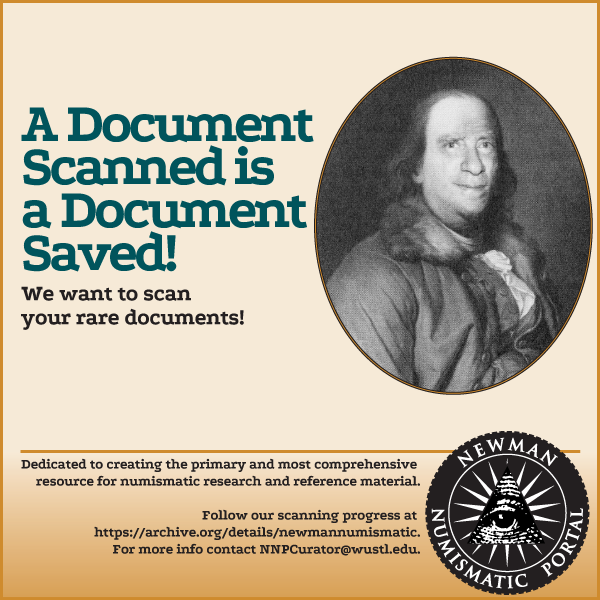
NEWMAN PORTAL DIGITIZES ANS COAC PROCEEDINGS
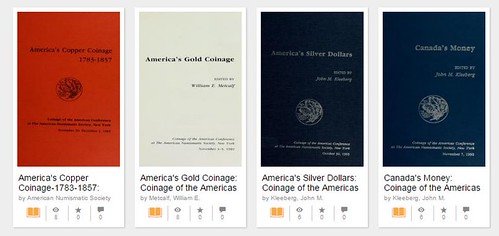
Newman Portal Digitizes ANS Coinage of the Americas Conference Proceedings
In 1976, The American Numismatic Society (ANS) published Studies on Money in Early America, edited by Eric Newman and Dick Doty. This volume featured 13 papers, all featuring original research on aspects of early American numismatics. The influence of Harry Bass and others led to a renewed focus on American numismatics, and in 1984 the first Coinage of the Americas Conference (COAC) was conducted at the ANS.
Although not formally part of the COAC series, the 1976 volume clearly acted as a precursor, and the 1984 COAC proceedings are similar in format to Studies on Money in Early America. The ANS has conducted the COAC periodically ever since, and so far 16 volumes have been published in the series.
The Newman Portal has gathered these together (some were already available in digital format, some have been scanned) and they are now available in the Newman collection on Internet Archive. A few stray volumes will be added soon to complete the series. The Newman Portal wishes to thank Andrew Reinhard, ANS Publications Director, for extending permission to scan and present these volumes on the Newman Portal.
To view the COAC volumes on Internet Archive, see:
https://archive.org/details/newmannumismatic?&and%5b%5d=Coinage%20of%20the%20Americas
THE ANS POLICY ON OPEN ACCESS TO PUBLICATIONS
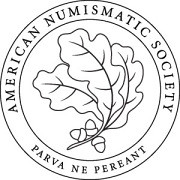 ANS Publications Director Andrew Reinhard outlined the society's approach to Open Access to its publications in a January 14, 2016 post
if the ANS Pocket Change. Here are a few excerpts, but be sure to read the complete article online for a thorough review of the current
landscape for academic and scholarly publications. -Editor
ANS Publications Director Andrew Reinhard outlined the society's approach to Open Access to its publications in a January 14, 2016 post
if the ANS Pocket Change. Here are a few excerpts, but be sure to read the complete article online for a thorough review of the current
landscape for academic and scholarly publications. -Editor
Why the American Numismatic Society is Open Access . . . and why your institution, learned society, publisher, etc., should be, too
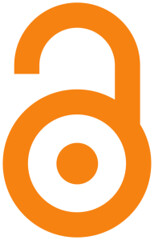 Academic and scholarly publication is at a crossroads as publishers, authors, and institutions of research and higher learning consider
both the financial and ‘moral’ implications of publishing new scholarship as Open Access. The American Numismatic Society (ANS) has adopted what some
would consider a progressive approach, while others would find these points to simply be common sense and good manners.
Academic and scholarly publication is at a crossroads as publishers, authors, and institutions of research and higher learning consider
both the financial and ‘moral’ implications of publishing new scholarship as Open Access. The American Numismatic Society (ANS) has adopted what some
would consider a progressive approach, while others would find these points to simply be common sense and good manners.
As you read the points below, I challenge you to formulate arguments against each one that does not include money. Profit and loss in academic publishing is a very real concern, but it can be demonstrated (and has been in my nine years of experience as an academic publisher) that publishing niche scholarship is (and likely always will be) a money-losing venture. Publication is often built into the mission statements of learned societies, and funding needs to be sought from sources beyond book sales and journal subscriptions to keep the publishing enterprise sustainable.
The ANS has addressed each of the following problems in its efforts to make published research open without taking a hit financially.
Problem: Profit-Based Publishing
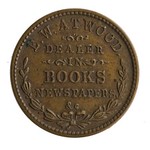 One of the greatest mistakes a learned society or institution can make is to become focused on making its publications turn a profit.
Scholarly publications typically cater to a niche market and sell dozens or occasionally hundreds of copies over a period of three years. Sales
beyond three years of the original publication date are rare. If an organization recognizes the fact that it will realize little (or no) profit from
the sale of what it publishes, it can strategize how to pay the not inconsiderable production costs. These costs can be built into annual budgets,
can be inserted into grant applications for projects, and can be sought in the form of subventions. Basing choices of what to publish by what the
publisher (or Board) thinks will sell can be a mistake, especially when what is to be published fulfills the mission of the parent institution.
One of the greatest mistakes a learned society or institution can make is to become focused on making its publications turn a profit.
Scholarly publications typically cater to a niche market and sell dozens or occasionally hundreds of copies over a period of three years. Sales
beyond three years of the original publication date are rare. If an organization recognizes the fact that it will realize little (or no) profit from
the sale of what it publishes, it can strategize how to pay the not inconsiderable production costs. These costs can be built into annual budgets,
can be inserted into grant applications for projects, and can be sought in the form of subventions. Basing choices of what to publish by what the
publisher (or Board) thinks will sell can be a mistake, especially when what is to be published fulfills the mission of the parent institution.
What the ANS is Doing About It: The ANS favors a mission-based approach to publishing. It understands that some publications will never recover their production costs, but nevertheless that the content is exceedingly important in fulfilling the Society’s stated goals for research and dissemination of that research.
Problem: Print-Only Publishing
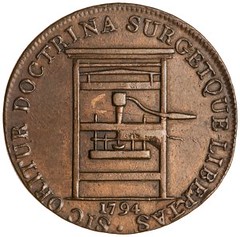 Arguably the biggest roadblock to Open Access research is publishing solely in print. Publishing in print restricts access to the content
locked on the pages and favors those readers with library access or the ability to purchase the publication. Print editions of scholarship, while
useful to many, are themselves silos of information, unable to interact with anything other than the active reader. This is the opposite of Open
Access. Making print editions available online as digital editions unlocks that content, making it searchable, and perhaps more importantly, gives
the content the ability to link to any other data available openly online, as well as making itself available to be linked to from other online
sources.
Arguably the biggest roadblock to Open Access research is publishing solely in print. Publishing in print restricts access to the content
locked on the pages and favors those readers with library access or the ability to purchase the publication. Print editions of scholarship, while
useful to many, are themselves silos of information, unable to interact with anything other than the active reader. This is the opposite of Open
Access. Making print editions available online as digital editions unlocks that content, making it searchable, and perhaps more importantly, gives
the content the ability to link to any other data available openly online, as well as making itself available to be linked to from other online
sources.
What the ANS is Doing About It: The ANS will continue to produce print editions of scholarship, but it will make digital editions of all of its publications past, present, and future available online as Open Access. Doing so allows the ANS to play well with others, to be a good academic citizen, and to contribute to the work of others. By sharing publications openly, this guarantees that multiple copies will be made and circulated thereby preventing loss of that content should something happen to the original publisher.
Conclusions
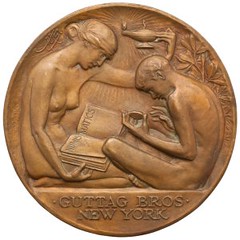 If Open Access publication of content is not part of your institution’s/society’s/publisher’s strategy, it should be. As authors and as
consumers of content, it is within your rights to ask (and in some cases demand) that your research (or the scholarship you need) be made openly
available online. Open Access does not require the cessation of the sale of that same content. Many readers still prefer to read printed books and
journals, and will pay for them (or will ask their libraries to pay for them). Most readers prefer a suite of media with which to work, using print
in concert with digital as they produce new scholarship.
If Open Access publication of content is not part of your institution’s/society’s/publisher’s strategy, it should be. As authors and as
consumers of content, it is within your rights to ask (and in some cases demand) that your research (or the scholarship you need) be made openly
available online. Open Access does not require the cessation of the sale of that same content. Many readers still prefer to read printed books and
journals, and will pay for them (or will ask their libraries to pay for them). Most readers prefer a suite of media with which to work, using print
in concert with digital as they produce new scholarship.
The end goal of the production of that scholarship should not be to make money, but instead to advance the humanities, arts, and sciences. The best way to do that is to make that scholarship available immediately to the world upon publication. Openly. The ANS hopes that other institutions, learned societies, and publishers will share in this approach to placing published work online without cumbersome restrictions. The Internet is genetically predisposed to facilitate such sharing, which makes it the greatest enabler of advancing our collective intellectual enterprise.
To read the complete article, see:
ON OPEN ACCESS (www.anspocketchange.org/on-open-access/)

DIANA HERZOG 1939-2016
 We received notice of the peaceful passing this morning of Diana Herzog, beloved wife of John Herzog. Diana is well known to many of you
not only as John’s wife, but also as a longtime and visible player in numismatic circles, as President of auction house and dealer R.M. Smythe, a
pivotal organizer of the legendary stock and bond conventions held annually in Strasburg for many years, and an active member of the Manuscript
Society, the Professional Autograph Dealers Association, and many other Brooklyn, Manhattan, Madison, and Southport organizations.
We received notice of the peaceful passing this morning of Diana Herzog, beloved wife of John Herzog. Diana is well known to many of you
not only as John’s wife, but also as a longtime and visible player in numismatic circles, as President of auction house and dealer R.M. Smythe, a
pivotal organizer of the legendary stock and bond conventions held annually in Strasburg for many years, and an active member of the Manuscript
Society, the Professional Autograph Dealers Association, and many other Brooklyn, Manhattan, Madison, and Southport organizations.
A Memorial Service will be held on Wednesday January 20th, 2016 at 3 PM at Trinity Episcopal Church , 651 Pequot Ave, Southport CT, a short walk from the Southport station on the New Haven line of Metro-North. A reception at the church will follow.
In lieu of flowers, donations to the Pequot Library, 720 Pequot Avenue, Southport CT 06890 are requested.
Diana was born on June 23, 1939, in Stoke-on-Trent, England, to Elinor (Ada Allen) and Reginald Rigby. Diana attended the Courtauld Institute, in London, earning a bachelor's degree. She then studied Medieval art in Frieburg, Germany, and later at the Institute of Fine Arts at N.Y.U where she achieved a Master's in Fine Art.
Diana moved to New York City in 1963, and married John E. Herzog, whom she had met on a trip to Mexico two years before. Diana and John lived in Manhattan, where Diana taught English as a second language at the New School, telling her devoted students that the pilgrims celebrated the first Thanksgiving in Philadelphia! Diana and John moved to Brooklyn Heights in 1972, where they were active in the Heights Casino and Plymouth Church. They summered in Clinton Corners, NY, where visitors could admire large vegetable beds and beehives, and later in Madison, in the beautifully restored "Red Top", with its view of the Long Island Sound.
Diana started her career in collectible financial documents at R.M. Smythe & Co., first researching obsolete and inactive securities and then branching out into the field of autographs as the firm expanded into a leading auction house. Diana was a formidable business woman, securing important consignments and putting collectors together with the items they sought.
Diana personally assembled autographs of British royalty, writers and poets, acquiring the nickname "Lady Di." Diana was active in the Junior League of Brooklyn, Resources for Children with Special Needs, and many industry organizations including as president of the Manuscript Society, and PADA. Diana enjoyed membership in the Cosmopolitan Club and the Grolier Club. Diana edited the magazine "Friends of Financial History" for many years, now published by the Museum of American Finance, which she and John nurtured for over 25 years.
As world travelers, Diana and John explored together, spending time in Europe and Asia, bringing home artifacts and anecdotes as well as cherished contacts. Diana accompanied John on many securities industry trips, supporting John at Herzog, Heine, Geduld.
Diana's love of art and opera, her linguistic talents, and her culinary skills were well known by her friends and family. Her tennis game was graceful, and she loved reading, especially British mysteries. Diana cherished her roots in England, visiting often to maintain close relationships with family and friends "across the pond."
To read the complete obituary, see:
Diana Herzog
(www.legacy.com/obituaries/ctpost/obituary.aspx?n=diana-herzog&pid=177320410&fhid=20390)
VIDEO: REDISCOVERY OF THE WALTON 1913 LIBERTY NICKEL

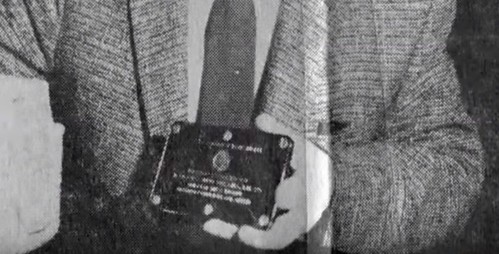
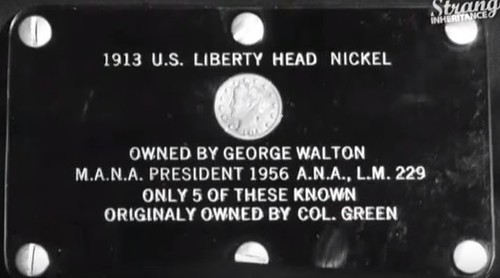
Walton Liberty Nickel holder
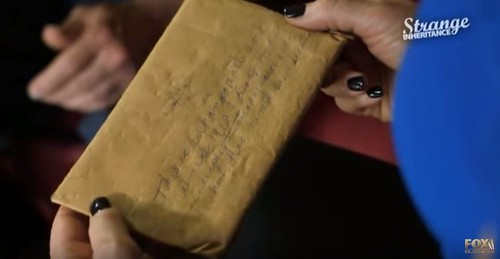
Walton 1913 Liberty Nickel holder envelope

To view the complete video, see:
The most valuable coin in the world… or a clever fake?
(https://m.youtube.com/watch?v=93z9zzbqL_4)
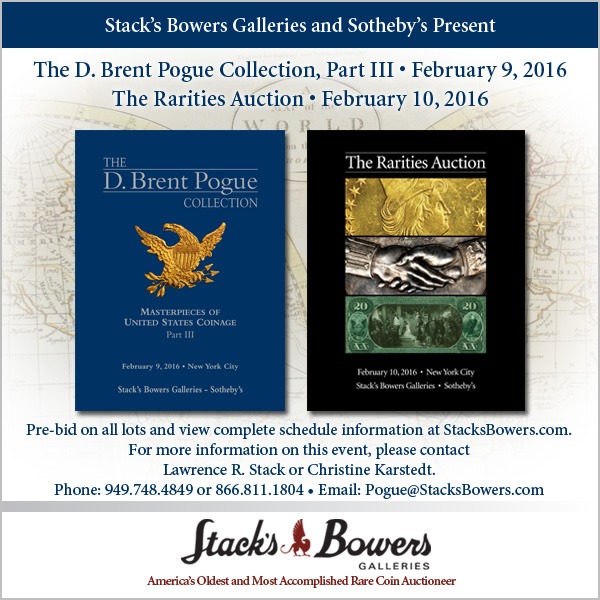
DICK JOHNSON'S TOPICAL BIBLIOGRAPHY
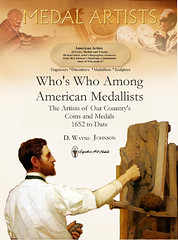 This is in reply to Dave Alexander's comment on the bibliography in his review of my Who's Who Among Medallic Artists in
last week's E-Sylum, Dave wanted a list of the numismatic references in one alphabetical list. Instead I list the books, articles and
films in a topical arrangement.
This is in reply to Dave Alexander's comment on the bibliography in his review of my Who's Who Among Medallic Artists in
last week's E-Sylum, Dave wanted a list of the numismatic references in one alphabetical list. Instead I list the books, articles and
films in a topical arrangement.
By classifying a large list of references -- over 800 in 69 pages -- I felt the topical arrangement increases the usefulness of the bibliography. I chose to catalog the references much like I catalog medals and tokens, by Topics. This brings related works together. I assigned a letter to each of 21 topical categories.
Surprise! Assigning a letter to similar topical works is exactly how the Library of Congress assigns their catalog number, the work's call number. "CJ" is the two-letter prefix for Numismatics in the L of C scheme of Subject Headings.. They must use a two-letter designation, however, because they catalog millions of books by this system.. .
After a letter designation I added a serial number for each publication in chronological order. This has the advantage of adding new works at the end as they are published.
The letters assigned were chosen for easy remembering. S for standard works, B for biographies, E for engravers, M for medals, V for videos and such. This left seven unassigned letters. This is where I assigned books and articles on individual artists of note spared across F through L.
Dave surmised a reader world have to remember a letter-number citation to look up the work's full listing. in the bibliography. He's right, but the letter has meaning. Isn't this more useful?
To read the earlier E-Sylum article, see:
BOOK REVIEW: WHO'S WHO AMONG AMERICAN MEDALLISTS
(www.coinbooks.org/esylum_v19n02a07.html)
NOTES FROM E-SYLUM READERS: JANUARY 17, 2016
Gary Beals Attending Long Beach Show
Gary Beals from Segovia, Spain writes:
I plan to go to press with my El Numiscadero English-Spanish Numismatic Dictionary in April. I will spend February 4 and 5 at the Long Beach Coin and etc. show. If there are any readers who want to chat with the guy from Spain, here is my California cell phone: (619) 495-3134. We will be down in San Diego Feb 6 -- March 11 -- then back to Spain.
More on Lorenzo Abbey's "Abbey Fly"
Regarding the biography of Lorenzo Abbey of the "Abbey Cent" , 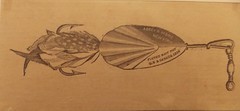 Steve Bishop writes:
Steve Bishop writes:
As any good fisherman can tell you, the "Abbey Fly" is not a fly at all, but a spinner.
To read the earlier E-Sylum article, see:
LORENZO HARRIS ABBEY (1822-1881) (www.coinbooks.org/esylum_v19n02a15.html)
U.S. Federal Currency Has Never Been Demonetized
Mark Tomasko writes:
"At the beginning of the article on demonetization of Pakistani bank notes is the statement "The United States only very rarely demonetizes a bank note design, and only then in very special circumstances." My understanding is that from the first federal currency in 1861 (I don't count the War of 1812) to today, U.S. Federal currency has never been demonetized. It is still redeemable at its face value. Gold and silver certificates are no longer redeemable in the metals but the notes are still valid US currency. The notes over $100 were withdrawn in 1969 but are still legal tender. We did have several "illegal to hold" situations – gold certificates from 1933- 1960s, and regular currency in Hawaii during WWII (currency not marked "HAWAII"), but both were temporary and the notes in question were redeemable.
"When I occasionally show a school group the Money Room at the Museum of American Finance on Wall Street in NYC, I usually ask "What is one of the most unusual features of US currency?" And after getting answers such as "the red and blue fibers" and the like, I say "It's not a physical feature" and go on to explain that from 1861 to today, US currency is still valid at its face value. Unlike many (if not most) countries, old designs are not demonetized."
To read the earlier E-Sylum article, see:
OLD-DESIGN PAKISTAN BANKNOTES TO BE DEMONETIZED
(www.coinbooks.org/esylum_v19n02a28.html)
Ken Hallenbeck's Credit Card Collection
Ken Hallenbeck writes:
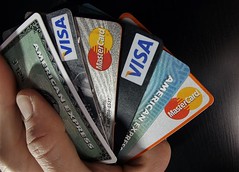 I always enjoy The E-Sylum, thanks for doing what you do. Toward the end of the last issue there was information about credit card
collecting, etc. I have an accumulation/collection of approximately fourteen to fifteen thousand cards. I'm not sure just how many, I just keep
accumulating them, and am too lazy to sit down and actually count them. Perhaps someday I will.
I always enjoy The E-Sylum, thanks for doing what you do. Toward the end of the last issue there was information about credit card
collecting, etc. I have an accumulation/collection of approximately fourteen to fifteen thousand cards. I'm not sure just how many, I just keep
accumulating them, and am too lazy to sit down and actually count them. Perhaps someday I will.
My oldest card is dated 1884 and is good for charging collect Western Union telegrams. Having this, I'm naturally looking for an older one. With all these cards, I do not have a 1950 Diners Club nor 1958 American Express card, and would love to acquire these someday.
I actually have a safe completely filled with credit cards, charge coins, and charg-a-plates. I started collecting them when I had graduated from the University of Michigan in 1955 and fulfilled my military commitment (Army) in 1957, which puts my time frame at late 1957 or 1958. It is fun to collect them and one never knows when one or more will turn up.
To read the earlier E-Sylum article, see:
MAN HOLDS RECORD FOR NUMBER OF ACTIVE CREDIT CARDS
(www.coinbooks.org/esylum_v19n02a27.html)

1929 FRENCH FOREIGN OFFICE MEDAL INFO SOUGHT
 I am hoping that your readers may help me to establish the provenance of a medal struck by Daniel Dupuis.
I am hoping that your readers may help me to establish the provenance of a medal struck by Daniel Dupuis.
What background information I have is as follows: ---
• The medal was issued in 1929 to Simon Eskenazi by the French Foreign Office (Le Ministere de Affaires Etrangeres) with the initial C.E.P added, possibly in recognition of service rendered.
• Present use of the initials C.E.P in relation to French affairs means the Confederation of European Probation, but whether this was so in 1929 I have no idea.
• The medal is currently in the possession of Simon Ashkenazi’s granddaughter, who lives here in Adelaide South Australia
• She has advised “Simon Eskenazi was Turkish - so Turkish grandfather, Italian/Greek grandmother - who met in Egypt where my mother was born, and then they came out in 50's , and I am first generation Aussie so to speak as my father is Aussie. Simon Eskenazi passed away in the 90's and this was an item left for me as the background.”
• She has also advised ... “From memory it is related to when you finished studies and he received this medal back in the day; background is Egypt.” Whether this was Secondary Schooling or Tertiary Study I do not know. The nearest I can approximate to it is Certificat d’aptitude professionnelle (CAP) at the end of Upper Secondary Education----- This level of education is provided over a three-year period to pupils ages 15-18. The general and technological lycées prepare pupils for long-term higher education, while professional lycées mainly prepare students for a career (although they have the option to continue their studies). The diploma awarded upon completion of the lycée, the baccalauréat, is a prerequisite for admission to university. In professional lycées, students can earn the Certificat d’aptitude professionnelle (CAP) after two years and the baccalauréat after two additional years. However, this system has been in France only since 1975, so whether there is any connection to the Education System in 1929 is problematic. There is a strong probability that the situations were very similar as the organisation of public education in France after the Revolution and the establishment of the French Republic goes right back to the Third Republic (1870 – 1940).
• If this educational connection is correct that would make this the equivalent of a Matriculation to University Study Medal. This would be consistent with “From memory it is related to when you finished studies.... “
• That leaves a problem of why such a medal would be issued by the French Foreign Office? ..... possibly solved if there was some form of secondary schooling based on the French Education System operating in either Cairo or Alexandria in the 1920s, even though at that time Egypt was a British Protectorate. Such an educational institution in Egypt using French Educational qualifications might well come under the administrative supervision of the French Foreign Office. There is a very slim chance that this coincides with the Pharaonist Movement in Egypt in the 1920s which was heavily influenced by French thinking.
• Another long shot at making a connecting link to the French Educational System in Egypt might be that if Simon Eskenazi was not only of Turkish origin , but had come from a Jewish Diaspora Community in Turkey to be part of the long standing Jewish communities in both Alexandria and Cairo, then the link becomes stronger. Jewish Communities (wherever found in the world) set very high store on University Education, especially for young men. Simon’s name is strongly similar to one of the most devout forms of Judaism, the Ashkenazi ---- may be a happy coincidence , but may be more significant than at first glance. From the foundation of the Alliance Israelite Universelle (AIU) in 1860 French Jews had been strongly involved in transforming the Jewish cause against anti-Semitism in Europe and the Middle East, especially through higher Education, and the Jewish Communities of both Alexandria and Cairo were both strongly influenced and supported by the AIU right up to the foundation of the modern State Israel in 1948. So if there were indeed French schools in both centres in the 1920s then the connection is possible.
I realise that my level of speculation may not be helpful or useful, which is why I am relying on your expertise. For the last six years I have been working as a retiree volunteer at the Migration Museum of South Australia: my responsibilities being accessioning new items into the collection, which includes establishing the provenance of such items and telling their story. I have had to do similar tracing to this medal for medals , coins (numismata) as well as all manner of artefacts donated to the Museum by people who have migrated here to South Australia. The Migration Museum of South Australia was set up in 1986 and was the first Social History Museum of its type in the World.
Any help you can give on the story of the medal, including its valuation would be very much appreciated.
CHAPMAN BUSHNELL SALE LOT #1668 BUYER SOUGHT
I would like to know who bought lot #1668 Chapman Auction June 20-24, 1882. This was the Bushnell Collection. I have a price of 15 cents but no name. Maybe someone in E-Sylum land will have an answer for me.
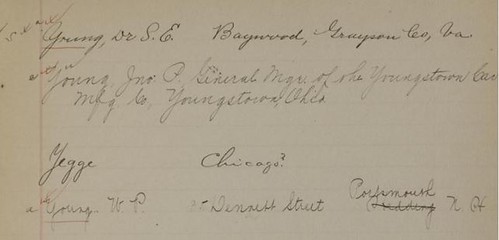
To read the Chapman Bushnell catalog on Internet Archives, see:
https://archive.org/details/bushnellcatalog1882chap
LOTTERIES IN COLONIAL AMERICA

As Powerball mania sweeps the nation, I thought it would be interesting to explore the longer history of lotteries in America with a look back to the eighteenth century. For a run-down of the particulars about how they operated, Ainsworth Rand Spofford, who served as the official Librarian of the United States, wrote a useful introduction to the subject... By way of a short summary, the practice of holding lotteries to raise money for local governments and private entities was brought by English colonists to North America in the seventeenth century. The Third Virginia Charter of 1612 granted the Virginia Company of London a license to conduct yearly lotteries to raise funds for supplies for early colonists. Spofford goes on to note that the award for what seems to have been the first proper lottery to take place in colonial America in 1720 was rather unusually for a brick house in Philadelphia rather than a cash prize.
As an essentially speculative venture, lotteries bred a certain amount of attendant trouble as they were easy to manipulate and in some cases the holders simply neglected to have a drawing and made off with the money altogether. Abuses such as this led to a swath of legislation, but both private and public lotteries proliferated. The more reputable ventures were authorized by local governments and fronted by prominent citizens, frequently with the aim of funding some worthwhile public project. As Spofford notes, it was looked upon as a kind of “voluntary tax” for public works, with the added benefit for subscribers of potentially getting a windfall.
The American Numismatic Society holds about a dozen eighteenth-century lottery tickets. They are interesting in part for the numismatic and economic information they reveal, but also in terms of their design. Counterfeiters could easily manufacture a ‘winning’ lottery ticket because they were pen-numbered (and thus easily altered) and it took time for reports of the numbers to circulate and for winning tickets to be redeemed. Precautions needed be taken to prevent chicanery, which led to some innovative features.
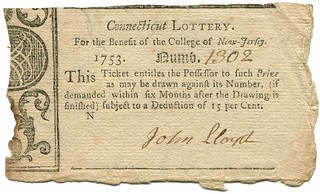
The 1753 Connecticut lottery ticket above has a seemingly haphazard left edge because it was cut from a larger sheet. Anyone redeeming a winning ticket thus needed to have both the correct number and an edge matching the original sheet to validate its authenticity. Because the lottery was so much smaller, tickets were simply issued with consecutive numbers over the much more complex systems of today. Incidentally, this 1753 lottery was one of several held for the benefit of the “College of New Jersey,” i.e. Princeton University, and this particular one seems to have funded the construction of Nassau Hall.
Arguably the most important lottery in American history was created by the Continental Congress in 1776 for “carrying on the present and most just and necessary war.” The “scheme” of the inaugural United States Lottery rather entertainingly refers to ticket holders as “adventurers.” Tickets were issued in different classes as the amount of awards and the cost of tickets escalated. This “Class the Third” ticket in the ANS collection was rather curiously signed but not seemingly issued as it lacks a number. Note the lines in the ‘No.’ field, which was meant to prevent alteration after a given ticket had a number written on it.
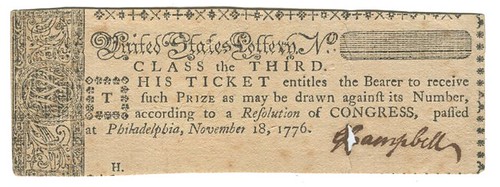
Just as the issuing and counterfeiting of Continental currency was part and parcel of the larger conflict, financing via lottery was another arena of contention. The ticket below was used as part of a Loyalist lottery held in British-occupied New York City in 1777 to raise money for the provisioning of British troops.
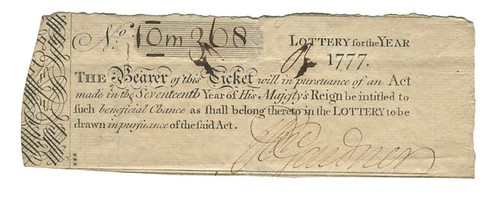
Although the rebellious colonists prevailed, the victory seemed to have done little to whet the public’s appetite for the lottery, and they proliferated in the United States during the late eighteenth century. A series of scandals in the nineteenth century, and the burgeoning of more or less fraudulent commercial lotteries hurt their reputation, but as today’s Powerball drawing suggests, the lottery still occupies a prominent place in American life and continues to play a significant role in funding public projects.
To read the complete article, see:
LOTTERY MANIA IN COLONIAL AMERICA
(www.anspocketchange.org/lottery-mania-in-colonial-america/)

WOODEN MONEY COLLECTORS EXPAND MEMBERSHIP

The International Organization of Wooden Money Collectors (IOWMC) had a banner year under the leadership of President Bob Gabriel. Through outreach, the club’s membership actually increased. We raised over $950 through donations and monthly mail bid auctions, and managed to reduce costs by increasing email distribution of our monthly newsletter; Bunyan’s Chips. These successes have allowed us to keep our annual dues at $7.50. Plans for 2016 center around our presence at the Central States show in April, where we will have a club table and our annual meeting. If you would like to be a part of the resurgence of the wooden money hobby - send $7.50 with your name, address and email to Maurina Schmidt, PO Box 1, Macedon, NY 14502-0001. Membership application requests can also be sent to IOWMC@yahoo.com .
SKYLAB PLASTER MODELS FROM SCULPTOR'S ESTATE
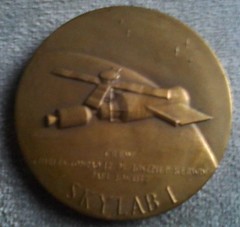 Amongst my collection of weird exonumia are two plaster models for Skylab I and II medals from the estate of sculptor Adlai Stevenson
Hardin. Both plasters are about 12 inches in diameter. Medallic Art Company struck medals from these in bronze and silver sometime during the late
1970's. Hardin was a cousin of Democrat Adlai Stevenson and died in 1989. I purchased these from a seller who bought them at a Lyme, Connecticut
estate auction after Hardin's death. Mr. Hardin apparently had a studio and lived near Lyme.
Amongst my collection of weird exonumia are two plaster models for Skylab I and II medals from the estate of sculptor Adlai Stevenson
Hardin. Both plasters are about 12 inches in diameter. Medallic Art Company struck medals from these in bronze and silver sometime during the late
1970's. Hardin was a cousin of Democrat Adlai Stevenson and died in 1989. I purchased these from a seller who bought them at a Lyme, Connecticut
estate auction after Hardin's death. Mr. Hardin apparently had a studio and lived near Lyme.
The Skylab missions were largely forgotten and flew between the Apollo and Space Shuttle missions. I love interesting and unusual exonumia. Problem is I have no idea of their actual value. I would appreciate any comments, suggestions, or estimates from anyone. All I'll say is that I have yet to locate another plaster model from a struck medal.
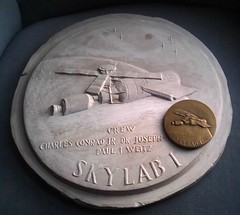

To read the complete article, see:
MY WEIRD STUFF - SKYLAB PLASTER MODELS FROM
SCULPTOR'S ESTATE (www.money.org/forums/exonumia/my-weird-stuff---skylab-plaster-models-from)
THE BOOK BAZARRE
COIN TELEMARKETING PIONEER STANLEY APFELBAUM
David Alexander has published a fairly detailed article about coin telemarketing pioneer Stanley Apfelbaum. It's not a flattering portrait, and such is the nature of a business built on finding legions of unknowledgeable buyers. Here's an excerpt - be sure to read the complete version online. -Editor
Few figures involved in the world of 20th-century commercial numismatics made as great an impression in their day as New York attorney and telemarketer Stanley Apfelbaum (born 1931, died 1990). For nearly 30 years, he was a pioneer and leading figure in the controversial, rough-and-tumble field of coin telemarketing – the sale of coins over the telephone to buyers generally ignorant of the product and of the realities of the real coin market.
Apfelbaum’s legal career began with study at New York University and St. John’s University Law School. Graduating in 1956, he passed the New York State Bar exam and practiced briefly as a litigator. The New York bar exam is no walk in the park, as lawyers know; it took the late Robert F. Kennedy five tries to pass that formidable barrier.
Apfelbaum was later disbarred, but this did not perceptibly slow down his numismatic career. Details of his personal life are little known and generally irrelevant to his sometimes stormy career. He was married twice, with four children and four stepchildren. He died at age 59 of an undisclosed form of cancer.
First Coinvestors, Inc.
In the early 1970s there was virtually no regulation of coin sales anywhere in the U.S. During these years there occurred a great flowering
of dynamiting over the telephone by fast-talking commission salesmen. Apfelbaum went public in 1969 as First Coinvestors Inc. (FCI)
actually achieving listing on the New York Stock Exchange. This stock was hustled in the FCI Rare Coin Advisory in the 1970s with marvelous
claims of increasing value but in the long run proved worthless.
Telemarketing by its very nature requires the continuous acquisition and dispersal of thousands of coins week by week and month by month. Properly understood, rare coins are pieces that cannot be found by the hundreds or thousands for quick resale over the telephone or by direct mail solicitation. In 1970s’ telemarketing, however, “rare coins” came to mean “coins that may be rather old, of which we have obtained a healthy supply.”
Whenever possible, Apfelbaum employed numismatists of real reputation to burnish FCI’s image with their own. These individuals were frequently coupled with an array of “societies” and “clubs” cobbled up to lend luster to material that was often of indifferent quality and value. Additional “experts” were created and heavily advertised to give an appearance of solidity to the oft-exaggerated claims of importance and value of the coins offered.
Walter Breen
The most ruthlessly exploited of these figures was numismatic genius Walter Breen (reportedly born 1928 or 1930; died 1993).
Breen first appeared on the numismatic stage in the early 1950s after discharge from the Air Force. “Discovered” by dealer John J. Ford Jr., he was commissioned by the great publisher-numismatist Wayte Raymond to conduct numismatic research in the National Archives.
It can be fairly said that Breen transformed the world of U.S. numismatics through these researches.
His monographs and books were many. The earliest were short studies published by Lee F. Hewitt of Numismatic Scrapbook magazine, several dealing with die varieties of early U.S. gold coins. After tying up with Apfelbaum, several full-length books were published under the rubric of F.C.I. Press.
A book of great potential value as well as frustration was his 1977 Encyclopedia of United States and Colonial Proof Coins, 1722-1977. Proof coins, struck on polished blanks with polished dies, are among the rarest and most desirable U.S. coins. For more than a century “Proof is better” dictated value and inspired endless dealer and collector attempts to show that whatever specimen they were trying to sell or buy was “Proof.”
Breen’s attempts to decree what was really Proof and what was not led to endless wrangling with no clear-cut agreement. Most ambitious was his massive 754-page Complete Encyclopedia of U.S. and Colonial Coins (1988), published by Doubleday with subscript F.C.I. Press. This book included a staggering amount of information and nearly all U.S. coins since the earliest colonial issues and is still widely consulted today.
The Swiatek-Breen Commemorative Book
A book that took on a note of sinister comedy was the 1981 Encyclopedia of United States Silver & Gold Commemorative Coins,
1892-1954. As published, it bore the names of Anthony Swiatek and Walter Breen, although Swiatek was the primary author (responsible
for more than 90 percent of the book, which bore the names F.C.I. Press and Arco Publishing).
I became aware of this title much earlier. As a new member of the weekly newspaper Coin World staff in early 1974, I was told one morning to drive down to Dayton International Airport to pick up a “New York school teacher who’s got some book idea!”
Amos Press did not then publish books but I dutifully intercepted the author, a young Brooklyn science teacher carrying an amazing manuscript bursting with all the information the author could find about each U.S. commemorative issued up to that time. Publisher J. Oliver Amos and Editor Margo Russell agreed to run the manuscript serially as a Coin World column.
Swiatek continued striving to find a publisher and fell in with Stanley Apfelbaum and FCI. Apfelbaum decided that here was a golden opportunity to “Breen up” the manuscript and exploit it as a selling tool for FCI. Walter obsessively hated commemoratives, calling them “speculators’ trash.”
He fitted each issue into a skeleton formed by a barrage of pseudo-lawyeresque language including Corpus Delecti, Suspects, Accessories, Modus Operandi and other hostile foolishness without Swiatek’s knowledge or consent.
Apfelbaum inserted pages of unauthorized and misleading FCI “investment” blither heavy with Breen quotes. These included ballyhooing the ultra-common Booker T. Washington-George Washington Carver half dollars as wonderful investment opportunities. Amazingly, the book still contained enough of Swiatek’s writing to make it worth consulting and some 5,000 copies were sold.
Apfelbaum the Boss
Apfelbaum was notorious for harsh treatment of his employees.
Late in the 1970s, Long Island was hit head-on by a disastrous blizzard. The New York State Police closed all roads to allow unimpeded snow removal, but Apfelbaum activated the phones and ordered ALL to report for work immediately or face dismissal. Similarly, he once ordered every Jewish employee taking off the High Holy Days to present signed notes from their rabbi attesting to their presence at services, “or else.”
Faced with ANACS and greatly increased public awareness–not to mention decades of complaints and legal actions–the once-mighty FCI filed for Chapter 11 bankruptcy in 1989. By then Stanley Apfelbaum had already launched American Coin & Stamp Ventures in 1986. The bloom was definitely off the telemarketing rose by the end of the ’80s though both Florida and Minnesota remained as hotbeds of the rawest forms of telephone hustling for years after.
Stanley Apfelbaum faded from public consciousness. His obituary in the January 1991 issue of The Numismatist, journal of the ANA, was an exercise in unsatisfying brevity that wholly ignored his legal troubles and ultimate disgrace. Four lines were devoted to the grading wars; none to his ANA expulsion. The briefest mention and swift oblivion seem to have been the goals and if so, they succeeded.
Would anyone know where to find a picture of Apfelbaum? No bio is complete without a portrait of the subject. -Editor
To read the complete article, see:
Stanley Apfelbaum and Coin
Telemarketing’s Wild West Era (www.coinweek.com/education/numismatic-history-stanley-apfelbaum-coin-telemarketing/)
HIRAM EDMUND DEATS (1870-1963)
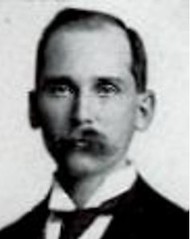 Hiram Edmund Deats "the Sage of Hunterdon County" (1870-1963), was born at Brookville, Hunterdon County, New Jersey, on May 20,
1870, son of Hiram Deats (1810-1887) and Elmira Stevenson (1830-). His father was a very wealthy farmer and bequeathed to his son a fortune.
Hiram Edmund Deats "the Sage of Hunterdon County" (1870-1963), was born at Brookville, Hunterdon County, New Jersey, on May 20,
1870, son of Hiram Deats (1810-1887) and Elmira Stevenson (1830-). His father was a very wealthy farmer and bequeathed to his son a fortune.
At the age of 16, he joined the American Philatelic Association (name changed permanently since 1908 to American Philatelic Society).
As a youth, Deats started collecting postage stamps of the United States and the Confederate States of America, and eventually created one of the finest collections of his era, eventually selling the collection. Deats specialized in the collecting of United States revenue stamps, and his collection, which in 1888 included the revenue collection of Edward Boker Sterling, was unsurpassed.
Deats amassed one of the finest libraries of Philatelic Literature in the United States, rivaling that of John Kerr Tiffany and that abroad of Lord Crawford, which, in 1952, he donated to the Free Library of Philadelphia.
He served on the first Board of Trustees of the ANA. He was also a member of the ANS. He collected New Jersey coppers, Masonic medals, curios, stamps, and paper money. Collected especially encased postage stamps. He was a Fellow of the ANS in 1890. He was an active life member of the ANS since January 20, 1880. He advertised looking to buy the deluxe editions of Frossard’s Nos. 161, 163, 165, 166, and 170 printed on thick paper. He also advertised to buy encased postage stamps.
He served as a member of the Grand Jury, which indicted Bruno Richard Hauptmann in 1934 for the kidnap murder of Charles A. Lindbergh, Jr.
He died at the age of 92 at the Union Forge Nursing Home near Clinton, New Jersey. His wake was held at the Holcombe Funeral Home, and was buried at the Cherryville Mountainview Cemetery, Flemington, New Jersey. After his death on March 16, 1963 his son Charles T. Deats, of Plainfield, New Jersey, sold the remaining numismatic literature to Allen Levine who years later sold the bulk of them to John N. Lupia.
To read the complete article, see:
DEATS, HIRAM
EDMUND (https://sites.google.com/site/numismaticmallcom/encyclopedic-dictionary-of-numismatic-biographies/deats-hiram-edmund)
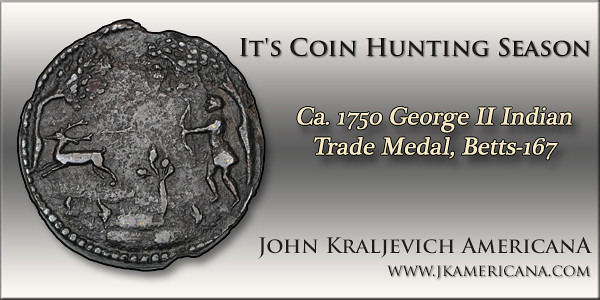
SELECTIONS FROM DAVISSON'S AUCTION 35
Lot 210: 1688 Maundy Set
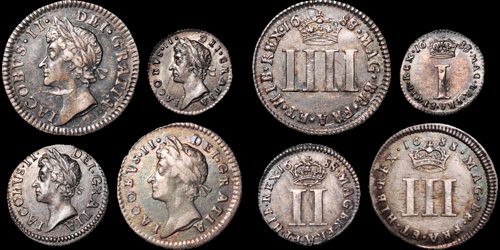
James II. 1685-1688. AR Maundy set. (Four coins). 1688. Bust of James left / Crowned Roman numerals indicating denomination. S. 3418. ESC 784 (S) (2383) [4d: 88/87 ESC 791 (1864) 3d: ESC 801 (1984). 2d: 88/87 ESC 809 (2297). 1d: 88/87 ESC 816 (2297)].
To read the complete lot description, see:
https://davcoin.com/lot/printed-auction-35-lot-210
Lot 291: Mary Stuart Ryal
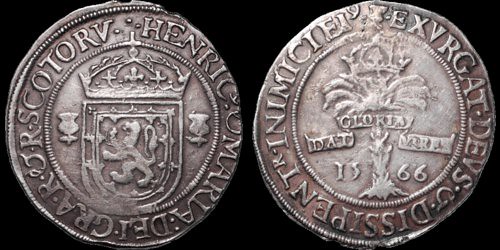
SCOTLAND. Mary Stuart (after Abdication). 1542-1567. AR ryal. 29.71 gm. 46 mm. Irregular striking (see references noted below) (457 grains, appropriate weight for the ryal issue). Dated 1566 but probably struck around 1572. Crowned shield, thistle each side; HENRIC & MARIA DEI GRA R & R SCOTORV around / A tortoise climbing a palm tree; DAT GLORIA VIRES on a scroll; 1566. S. 5425 type. SCBI 58, Edinburgh: 1189 (same dies). Good Very Fine.
Holmes, N. in SCBI 58 suggests "more likely an irregular striking." Rampling & Murray, BNJ 59 (1989), p. 213. "The Coinage of the Marians in Edinburgh Castle in 1572-an Addendum" discusses the issue and notes the Lockett example. and a reverse die match to a genuine die. Holmes (SCBI 58: 1189) refers to their work and believes this is best described as "an irregular striking."
To read the complete lot description, see:
https://davcoin.com/lot/printed-auction-35-lot-291
Lot 294: 1567 James VI Ryal
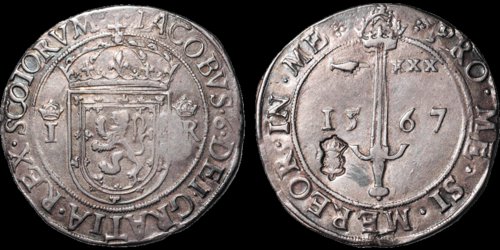
SCOTLAND. James VI. 1567-1625. AR ryal or"sword dollar" 30.33 gm. 42 mm. First coinage with thistle countermark, revaluation of 1578. 1567. Crowned shield of Scotland; I — R on sides, both letters crowned; IACOBVS 6 DEI GRATIA REX SCOTORVM / A sword, upright, a crown at the tip; a hand pointing - XXX in upper field; 15 - 67 across field in center; PRO ME SI MERIOR ("For me: against me if deserved"). S. 5472. Burns 350:6.
To read the complete lot description, see:
https://davcoin.com/lot/printed-auction-35-lot-294
Lot 305: Ireland Long Cross and Hand Penny
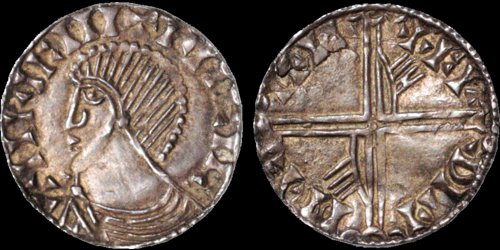
IRELAND. Hiberno-Norse. Phase III: Long Cross and Hand coinage, Circa 1035-1060. AR penny. .99 gm. 17 mm. Imitative of Aethelred long cross penny. Bust left; blundered legend / Voided long cross; stylized hands in two angles of cross; blundered legend. S. 6132.
To read the complete lot description, see:
https://davcoin.com/lot/printed-auction-35-lot-305
Lot 316: Ormond Siege Sixpence
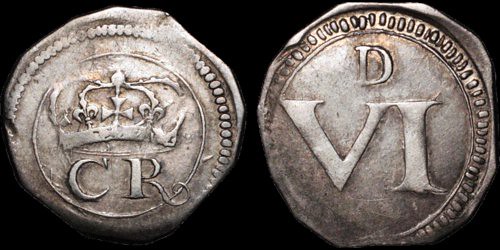
IRELAND. Charles I. 1645-1649. AR sixpence. 2.78 gm. 21 mm. Ormond Siege coinage. 1643-1644. Crowned C R, no dot between, in a circle / A large VI, D above; both in a circle. S. 6547. D&F 302.
To read the complete lot description, see:
https://davcoin.com/lot/printed-auction-35-lot-316
Lot 330: 1797 Poole Halfpenny
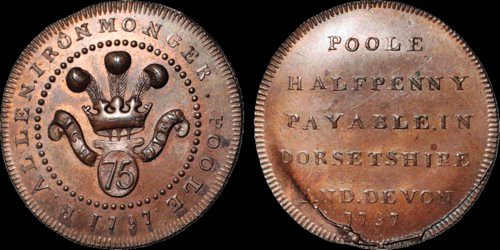
Dorsetshire 3a (RRR). Poole. Æ halfpenny. 9.35 gm. 29.5 mm. A high relief depiction of the crest of the Prince of Wales; R. ALLEN IRONMONGER POOLE 1797 / POOLE | HALFPENNY | PAYABLE IN | DORSETSHIRE | AND DEVON | 1797.
To read the complete lot description, see:
https://davcoin.com/lot/printed-auction-35-lot-330
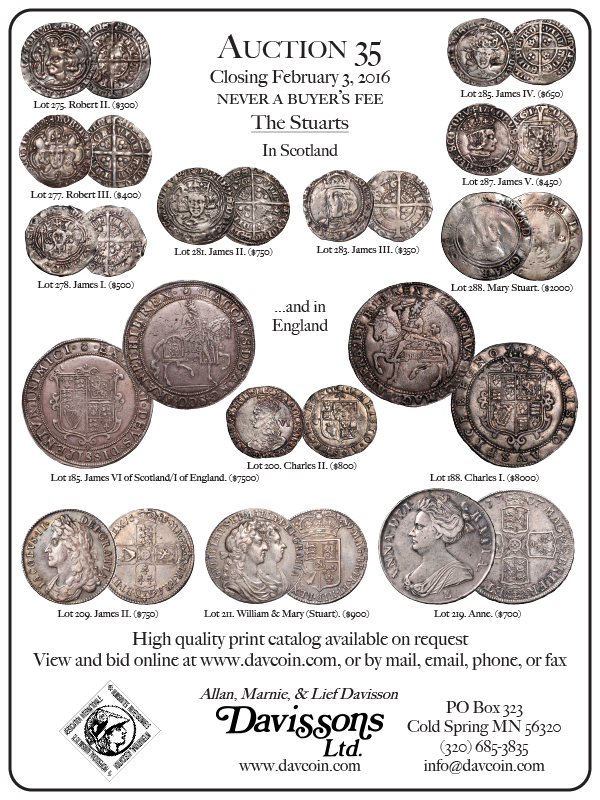
INDIAN MINISTER PROPOSES LAW AGAINST MELTING ANCIENT COINS
Ngpur: Minister of state for chemicals and fertilizers Hansraj Ahir on Friday said that he will pursue with the government the need to frame rules to prohibit melting of ancient coins. He said he will hold a discussion whether the act of melting should be brought under prohibition or not. "I personally believe that melting such precious heritage is a cruel act and the government should work on making strict laws to stop it from happening," he said.
"Ancient coins which form a very important proof of ancient civilization have been underrated by several generations. All they see is the value of metal the coin holds," said Ahir while addressing a three-day first international seminar on 'Gupta coinage' organized by the Coin Society of India held at a city hotel on Friday.
Society chairman Prashant Kulkarni, trustee Chandrashekhar Gupta, professor at Boston University Pankaj Tondon, researcher on Gupta coinage from Netherlands Alen Raven, former vice-chancellor of Kavi Kulguru Kalidas University Pankaj Chande, numismatic researcher from Oxford University Shailendra Bhandare and numismatic researcher from the United States Sanjeev Kumar were seated on the dais.
Talking about Gupta coinage, Ahir said, "In Indian history, the Gupta kings' rule between 3rd and 5th century AD is considered as a golden era. Every single coin that was minted in that age was made in gold, called 'dinaar'. It signifies the level of prosperity we had then. Being a Lok Sabha member I am realizing that India is slowly coming back to where it was."
Talking to TOI about the significance of 'Gupta', Kulkarni said, "There is one peculiar thing about every Gupta coin. Minted in gold, they all had exquisite pictorial representations punched on them, unlike other coins which usually have scripts or symbols. The Guptas have a series of coins depicting various qualities that a king should have. One coin showcases a king playing Veena, signifying that a king should have a sense of music. On other coin, a king is performing 'Ashvamedha', depicting strength. There is also a coin in which the king is shown as lion slayer."
"Gupta has always stood as a proud dynasty. The famous Nalanda University flourished in the reign of king Kumar Gupta who gave a lot of importance to education. We all know about Sanskrit scholar Kalidas lived during the reign of King Chandra Gupta ll," he said.
To read the complete article, see:
Ahir for
rules to stop melting of ancient coins
(http://timesofindia.indiatimes.com/city/nagpur/Ahir-for-rules-to-stop-melting-of-ancient-coins/articleshow/50597721.cms)
THE BOOK BAZARRE
ANS GALA: THE ‘ACADEMY AWARDS’ OF COIN COLLECTING
On January 7, on a brisk winter evening, a throng of the money-obsessed gathered at the Waldorf Astoria, on Park Avenue in New York. But unlike many meet-ups at this Manhattan moor, this occasion wasn’t marked by hedge fund managers, investment bankers, and corporate lawyers fixated on making more money. Rather, this group was consumed with the study, collection, and dealing of it. Such was the annual dinner gala of the American Numismatic Society (ANS), an organization devoted to the preservation and scholarship of coins and currency.
“This is our Academy Awards,” said Sydney Martin, the president of the organization. The event was part fundraiser ($600 per ticket), part awards ceremony in which numismatic luminaries were recognized for their contributions to the field. But a more apt comparison would have been the Golden Globes, as guests were seated under three dimly lit chandeliers and at round white-linen clothed tables, as they dined on a menu of cucumber wrapped chopped salad, sliced tenderloin au poivre (with sugar snap peas), and chocolate savarin.
Among the notable guests were David Bowers, a legendary numismatist, and one half the namesake of Stack’s Bowers Galleries, an auction house and coin dealer located near Carnegie Hall. Larry Stack whose family founded the firm was also in attendance.
Also joining the occasion was Paul Volcker, former chair of the Federal Reserve, who isn’t a coin collector. “But once I got a bunch of coins from my grandmother, and they weren’t worth anything,” he said. He was there to support his friend John Adams who he had met on a fishing trip. Adams, along with his wife Regina, were the recipients of the Trustees’ Award, which honors those who have advanced the mission of the ANS. Adams was the founder of a Boston-based investment bank, and has written several numismatic works including Monographs on Varieties of United States Large Cents, 1793-1794. In his acceptance remarks, Adams confessed that numismatists are an odd bunch, but “these eccentricities are endearing,” he said.
One of the charming qualities of these collectors is how they see their muse as portals to the past. “Unlike an Ionian or Roman vase that is locked away at a museum, you can actually touch the coins that circulated in these ancient worlds,” said Matthew Wittman, an assistant curator at the ANS who runs their blog Pocket Change. “They are little pieces of history that anyone and everyone can interact with,” he said. At his table was a wide cross section of professionals who had fallen for the coin — an electronic technician interested in New Jersey pieces and a radiologist who wrote a book on pine tree shillings.
To read the complete article, see:
Welcome to the ‘Academy Awards’ of Coin Collecting
(http://fortune.com/2016/01/16/coin-enthusiasts-collectors-money/)
To read the earlier E-Sylum articles, see:
http://www.coinbooks.org/esylum_v19n02a24.html
(www.coinbooks.org/esylum_v19n02a24.html)
BOOK REVIEW: COINED (www.coinbooks.org/esylum_v18n11a05.html)
BOOK REVIEW: COINED (www.coinbooks.org/esylum_v18n12a07.html)
BOOK REVIEW: COINED (www.coinbooks.org/esylum_v18n22a06.html)

WAYNE’S NUMISMATIC DIARY: JANUARY 17, 2016
On Tuesday January 12, 2016 I arrived about 6pm at the Mon Ami Gabi restaurant in Reston Town Center for the monthly dinner of my Northern Virginia numismatic social group, Nummis Nova. Roger Burdette was already there. Soon we were joined by my guest Robert Hoppensteadt of Alexandria, VA, who had learned about us on Meetup.com. He writes:
I collect ancient coins, and I have built and sold a few collections (one generalist and one focused on Republican and Imperatorial silver). For the past 10 years I have been collecting Roman Provincial bronzes with a specific focus on architectural themes. I am a serious collector and have a lot of knowledge built up over the past 25 years concerning most areas of ancient coinage, and I also have an interest in American coins as well, particularly colonials and early federal though I don't collect them.
The reason I chose to collect the provincial coinage is for the historical aspects - most of it is local and city specific, and a lot of the buildings portrayed on the reverses are the only extant images of them and they have actually helped archaeologists reconstruct what they looked like in some cases.
My latest acquisition was an Alexandrian hemidrachm of Hadrian with a reverse picturing the Pharos light house - of special interest to me because I live in Alexandria and the large Washington memorial that overlooks the town is based upon that ancient structure.
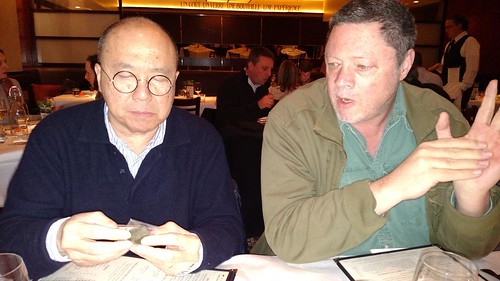
Ed Moy and Robert Hoppensteadt
Among the next group of arrivals was former Mint Director Ed Moy, who sat across from me and next to Robert. Above he's examining Robert's coin.
Wayne Herndon was our host, although I didn't get to speak with him much, being kind of trapped in the middle of a bench with no way out. But I enjoyed conversing with my immediate neighbors. Joe Esposito was on the other side of Ed, and to my left and right were Mike Packard and Tom Kays. Other attendees included Eric Schena, Jon Radel, Steve Bishop, Gene Brandenburg and Dave Schenkman. Howard Daniel was still in Viet Nam, Julian Leidman was absent for his wife's birthday, and Joe Levine was feeling under the weather.
The Oreo Triathalon Medal
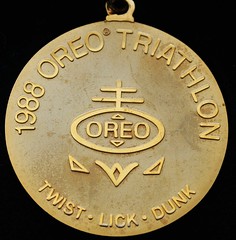 One never, ever knows what one might see at one of these events. A case in point is this 1988 Oreo Triathalon medal brought in by Gene
Brandenburg. Thanks to Dave Schenkman for the images. If I had a nickel for every cookie I've eaten I'd be rich by now. Maybe I deserve a
medal.
One never, ever knows what one might see at one of these events. A case in point is this 1988 Oreo Triathalon medal brought in by Gene
Brandenburg. Thanks to Dave Schenkman for the images. If I had a nickel for every cookie I've eaten I'd be rich by now. Maybe I deserve a
medal.
Dave adds:
The overall length is approx. 143mm; the medal itself is 60mm. It appears to be gilt brass.
These turn up for sale periodically online. I came across this information in an eBay lot description:
You’re bidding on a very rare OREO Triathlon 24k gold plated medal and a piece of original advertising from the 1988 “OREO Triathlon Sweepstakes” held during that year’s Summer Olympics in Seoul, South Korea. This was given to me by one of the advertising people who developed the promotion for Nabisco and it has been in his possession since 1988. As he recalls, the piece was made to the dimensions of an Olympic medal by the same firm that produced the actual medals that year. As can be seen in the official rules from the 1988 advertisement, only 5,000 of these 24kt gold plated medals were produced.
To read the complete lot description, see:
24kt Gold Plated 1988 Oreo "Triathlon Sweepstakes" Olympic Style Medal w/ Ad
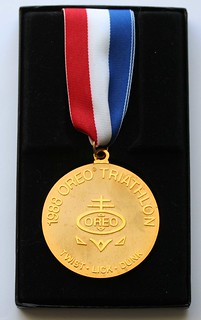
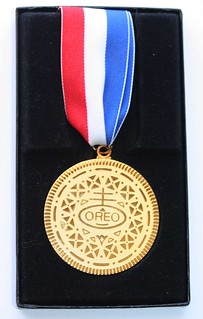
Here's a May 1, 1988 ad from The Palm Beach Post via newspapers.com:
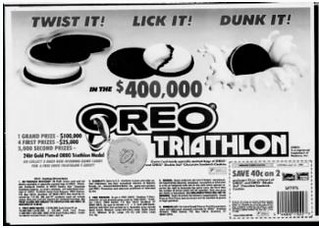
The Nickel Exchange Association
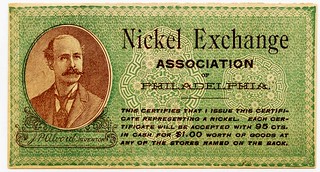
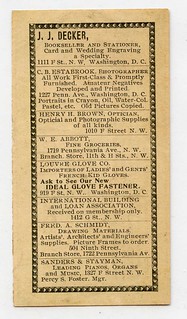 Dave Schenkman also passed around this interesting item which could use some additional research. It appears to be a "coupon"
item promoting certain Washington, D.C. businesses, but the front declares it to be from the " Nickel Exchange Association if
Philadelphia." Are there more of these out there with different merchants or locations?
Dave Schenkman also passed around this interesting item which could use some additional research. It appears to be a "coupon"
item promoting certain Washington, D.C. businesses, but the front declares it to be from the " Nickel Exchange Association if
Philadelphia." Are there more of these out there with different merchants or locations?
Dave adds:
Gene Hynds showed it to me at the Chicago ANA convention last summer, and he ended up sending it to me as a gift. I’ve never seen any others, but would have to think there are others with different advertisements. I haven’t done any research, but I’d guess it to be circa 1900.
Tom Kays’ Numismatic Notes
I arrived in Reston after dark but before the snow flurries and took to the back bench next to Wayne and Steve. Once seated I was locked in for the night. Wayne introduced me to his guest Robert Hoppensteadt, a collector of “architecture” as depicted on ancient coins who sat opposite. Robert showed and told about a nice ancient bronze he brought, showing one of the seven wonders of the ancient world no longer standing, the Lighthouse at Alexandria, Egypt. Show and tells were passing at a furious pace after drinks and before the salad.
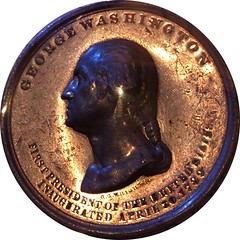
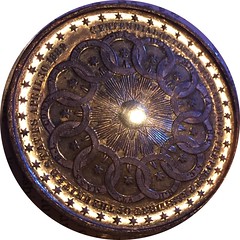
George Washington Inauguration Centennial Medal
From stage left (Dave’s direction) came a George Washington Inauguration Centennial Medal by Charles Cushing Wright, in white metal. The reverse is reminiscent of his earlier “Fill the Blessed Sun” reverse, with an original printed article done some years ago, about which I did not fully hear the story, but I did take a neat photo of the medal under fine dining illumination and still in the plastic, which lends rather an “artistic” look, considering the ocular disadvantages to proper iPhone portraiture when shooting by candlelight in a salad dish in such ambiance.
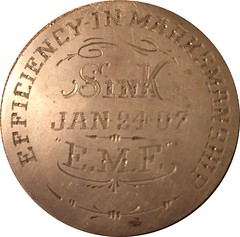
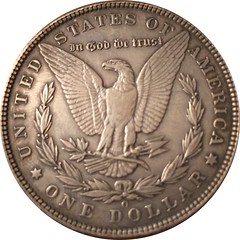
Efficiency In Marksmanship Medal
Since I was land-locked, Gene who sat far left, opposite Dave, and away off in the distance, later in the evening caught my attention, held up round shiny objects in one hand and then fingers on the other apparently either needing more drink from the waiter or perhaps indicating some sort of price as I found out afterwards. I nodded and just like sneezing during bidding, soon realized I bought a coin lot on faith in a silent auction. As always Gene did not disappoint. One coin was a Morgan dollar from New Orleans that had been shaved on the obverse and engraved with the words “EFFICIENCY IN MARKSMANSHIP – SINK – JAN 24 ’07 – E.M.F.” Another was a holed, 1887 Morgan dollar used as a civilian ID and dated “1917” that needs more research. Dave thought Gene should have held up a different configuration of digits but let’s not go there.
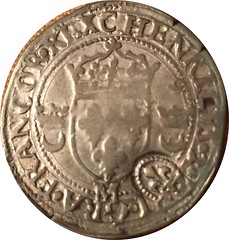

Counterstamped 1550 French Coin of Louis XIII
In a walnut relic case I brought some colonials and 17th century English trade tokens for Joe to appreciate (whom we thank publicly for speaking so enthusiastically to a room full of the kids at the Annandale Coin Show “event” in December that they asked for his autograph), but he sat beyond Ed and was lost in conversations at his end of the table with Mike who has grown a beard in retirement and sat incognito opposite. The oldest coin in the case was a French silver host, Louis XIII, 1550-dated, douzain aux croissants of Toulouse that became a sol de quinze with lis counter stamp in beaded oval, circa 1640, approved for export to Canada and Louisiana.
The far right end of the table held their own council among Roger, Wayne (with the moustache), Jon, and somehow Ed, who knew enough not to sit in the middle of the couch but to take a normal chair from which he could socialize with both ends of the table (an impressive demonstration of senior executive knowhow). What they said I don’t know having been locked into position by the twenty foot long couch on the far side of Steve.
Evening conversation topics amid-table wandered about among in depth discussion on how to foretell and monetize future events, world mints that make gold coins, ancients with the original “Britannia” figure on sale now, looking at the falling snow, drones, Elon Musk, Birmingham counterfeits, the Newman Numismatic Portal, original gold containers from Fort Knox, silver dollars with killer toning, Massachusetts copper varieties, NSA Challenge Coins, genuine French Berets, and Dutch glass onion bottles of black glass, or in other words a typical night with this crowd. An impressive example of one of these discussion items is sitting on Ed Moy’s desk as he spoke about it, but unless you were there you’ll have to guess which. It all ended way too soon but then again next month’s dinner is not that far away.

THE BRITISH VIEW OF COINS AS INVESTMENTS
Joe Esposito writes:
 The editorial in the December 2015 issue of the British publication Coin News highlights some differences between British and
American numismatics. John W. Mussell notes that the American emphasis on “the minutiae of grading,” slabbing and viewing coins as investments is
largely antithetical to British numismatists. And yet, he asks, with the aging of British coin collectors, is it appropriate to “learn a thing or two
from the Americans?” He ends by musing, “Is it time to take ourselves down that same path as they have trodden in order to expand our hobby, or is
that a step too far?” It will be interesting to see how that plays out.
The editorial in the December 2015 issue of the British publication Coin News highlights some differences between British and
American numismatics. John W. Mussell notes that the American emphasis on “the minutiae of grading,” slabbing and viewing coins as investments is
largely antithetical to British numismatists. And yet, he asks, with the aging of British coin collectors, is it appropriate to “learn a thing or two
from the Americans?” He ends by musing, “Is it time to take ourselves down that same path as they have trodden in order to expand our hobby, or is
that a step too far?” It will be interesting to see how that plays out.
"The slab has allowed the collector to buy and sell coins much more easily and this has led, logically, to a boom in coins as investment. In the UK, with grading being so subjective such trading solely as a money-making exercise isn’t quite so easy.
"... Is it now time to look at encouraging investors? Encourage the looking at coins as commodities as well as collectables? Is it (shock, horror) time to slab?"
To read the complete article, or for more information on Coin News, see:
December 2015, Volume 52 No. 12 Two nations divided by a common hobby
(www.tokenpublishing.com/issue.asp?iid=427)
CANADIAN COIN COMMEMORATES TRANSATLANTIC CABLE
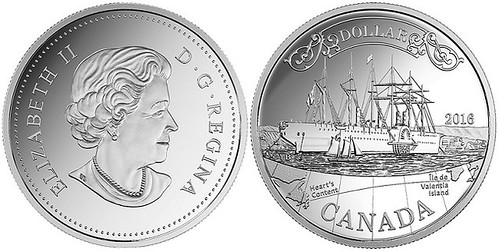
The Royal Canadian Mint has issued a new silver dollar recognizing the 150th anniversary the transatlantic cable, which has provided vital communication between the continents of North America, Europe, and the world over. This ingenious idea was ahead of its time, and its eventual implementation managed to connect both sides of the Atlantic Ocean via telegraph just before the invention of the telephone, which itself would one day be able to enable the peoples of both continents to speak to each other.
Canada played a significant part in this plan, since Newfoundland (later incorporated into the Canadian confederation in 1949) presented the ideal location for the transatlantic cable’s western terminus. In preparation, telegraph wires were quickly laid over land and across the Cabot Strait to connect the island to the wires over mainland Canada. Soon all was in place, minus the transatlantic cable itself.
In 1857, an initial attempt to lay a cable across the some-1600 mile distance proved unsuccessful when the cable broke. Perseverance and determination triumphed, however. Another series of attempts involving two ships proved successful in 1858. One ship sailed from the east and the other sailed from the west; they met in the mid-Atlantic, where the cable would be spliced together. A cable link was finally completed in August of 1858.
The first inaugural transatlantic telegraph between the two continents occurred when the Heads of State of the United Kingdom and the United States communicated. Queen Victoria sent a congratulatory message to the President of the United States, James Buchanan, although this first attempt had such poor reception that it took over 16 hours to transmit the message.
Disappointingly, the cable failed on September 3 under a high voltage charge. Further work on the Atlantic cable was hindered by the Civil War in America. It wasn’t until 1865 that a single ship would lay the cable in just one trip across the Atlantic. As the largest vessel at the time of her launch, the iron steamship S.S. Great Eastern was outfitted to hold the giant coils of cable that would cover the distance between Foilhummerum Bay on Valentia Island off of Ireland and Heart’s Content, Newfoundland.
The cable snapped once more and it too was lost to the ocean depths, but the following year’s attempt would prove more successful. On July 27, 1866, Great Eastern triumphantly steamed into Newfoundland’s Trinity Bay, the cable was pulled ashore at Heart’s Content, and history was made as the transatlantic telegraph cable was declared fully operational.
Remarkably, a second cable was in place shortly after, when the Great Eastern successfully retrieved and completed the efforts of the 1865 cable-laying project. It was all an unforgettable and extraordinary lesson in perseverance, and the cable succeeded in establishing a communication link that has remained unbroken ever since.
The coin, designed by Canadian marine artist Yves Bérubé, features a starboard side view of S.S. Great Eastern, as the iron steamship triumphantly rests in the harbor of Heart’s Content, Newfoundland. The Great Eastern easily dwarfs a local gaff-rigged fishing boat, known as a Jack Boat, off her bow, while her four funnels and six masts rise up to fill the upper portion of the reverse.
In the background, the fishing village and the hills that surround Trinity Bay are a welcome sight, signaling the end of one journey for the crew after spending weeks laying the transatlantic cable along the North Atlantic seabed. This historic cable linking Heart’s Content to Valentia Island, Ireland, is illustrated on the map element that fills the reverse’s lower portion. The cable itself is represented on the map. The obverse side includes the effigy of HM Queen Elizabeth II as designed by Susanna Blunt and used on all Canadian circulation, as well as many commemorative coins, since 2002.
To read the complete article, see:
Canada
Highlights 150th Anniversary of Transatlantic Cable on New Silver Dollar Coin
(http://news.coinupdate.com/canada-highlights-150th-anniversary-of-transatlantic-cable-on-new-silver-dollar-coin/)
THE BOOK BAZARRE
SPELLING ERRORS ON COINS
There are many quality control steps between the artist’s original conception of a coin’s design and the release of that coin into general circulation. Numerous individuals have the opportunity and the obligation to inspect the finished sketch, clay sculpture, copper galvano, plaster cast, master hub, master die, working hubs, working dies, and finished coins. It is therefore surprising how many obvious spelling errors have passed this gauntlet and entered circulation.
The addition, deletion, transposition, reversal, inversion and substitution of letters can take place at many points in the production process. The original sketch might contain the error, or it might slip in while translating the sketch into a clay bas relief model. If not caught and corrected, either of these mistakes would carry over into the fabrication of the master hub — the template for all of the dies produced in that year.
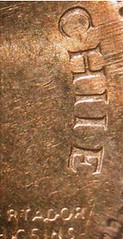 The illustrated 2008 Chile 50-peso coin shows the country spelled as CHIIE. The mint director lost his job after a hailstorm of ridicule
ensued. Also depicted is a 1999 Portugal 100-escudo that shows a letter deletion instead of a letter substitution. The country is spelled PORTUGUSA
instead of PORTUGUESA. This mistake probably traces back to the master hub, as the spacing of all the letters was altered by the missing letter. A
well-known spelling error (not shown) occurs on a 1922 Brazil 1,000-real coin where the name BBASIL appears beneath the twin busts on the obverse
face.
The illustrated 2008 Chile 50-peso coin shows the country spelled as CHIIE. The mint director lost his job after a hailstorm of ridicule
ensued. Also depicted is a 1999 Portugal 100-escudo that shows a letter deletion instead of a letter substitution. The country is spelled PORTUGUSA
instead of PORTUGUESA. This mistake probably traces back to the master hub, as the spacing of all the letters was altered by the missing letter. A
well-known spelling error (not shown) occurs on a 1922 Brazil 1,000-real coin where the name BBASIL appears beneath the twin busts on the obverse
face.
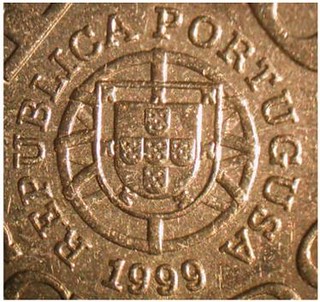
Other mangled geopolitical labels include a 1995 Argentina 1-peso coin that features a misspelling of the Spanish word for “province.” It is spelled PROVINGIAS instead of PROVINCIAS.

Our next illustrated specimen is a commemorative 1972 Egypt 5-piastre coin that shows a letter transposition. UNICEF is misspelled UNICFE. Although the individuals responsible for this issue may not have been proficient in English or English acronyms, one would think that the name of one of the world’s most prominent humanitarian organizations would have been more familiar to them.
Our last spelling error on a coin can perhaps be forgiven, as it involves a long Greek-derived zoological name for the Philippines monkey-eating eagle. The genus name for this raptor is PITHECOPHAGA (literally monkey-eater). It was misspelled PITHECOBHAGA on this 1983 Philippines 50-sentimo coin.
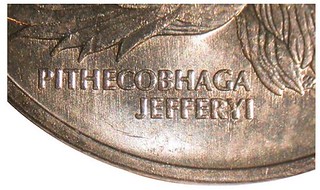
To read the complete article, see:
Obviously
not a spelling bee winner: Collectors' Clearinghouse
(www.coinworld.com/news/world-coins/2016/01/obviously-not-a-spelling-bee-winner-collectors-clearinghouse-column.all.html)
RUSSIA ISSUES A ‘CREDIT CARD’ COIN
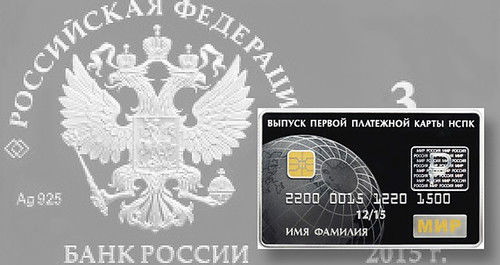
Last week we excerpted an article about a man who holds the record for the most current credit cards. Jeff Starck of Coin World writes:
It’s incredibly good timing that you mention collecting credit cards. Now, thanks to Russia’s central bank, coin collectors can collect a credit card shaped coin! Cash really is credit!
When it comes to “cash or credit,” the Central Bank of Russia is turning the question on its head.
On Dec. 15, the bank issued a noncirculating legal tender commemorative coin that celebrates the first credit card in the country. The Proof .925 fine silver 3 ruble coin is even shaped like a credit card.
The obverse of the coin bears an image of the state coat of arms of the Russian Federation, with inscriptions translating to “Russian Federation” and “Bank of Russia.” The denomination and year of issue, 2015, also appear, with symbols indicating the metal, purity and the Mint mark of the Saint Petersburg Mint.
The reverse side of the coin reproduces a credit card, with 16 “account number” digits, gold accents, and an apparent hologram (of the ruble symbol) meant to mimic security traits employed in actual credit cards. An inscription toward the upper part of the design translates to “Issue of the first payment card NSPK.”
The coin weighs 31.1 grams and measures 51 millimeters wide and 32 millimeters tall. The mintage limit is 5,000 pieces.
Interested collectors will have to search the secondary market to obtain this coin.
To read the complete article, see:
Russia issues a
‘credit card’ that’s also a coin (sort of)
(www.coinworld.com/news/world-coins/2016/01/russia-issues-a-credit-card-that-is-also-a-coin-sort-of.html)
To read the earlier E-Sylum article, see:
MAN HOLDS RECORD FOR NUMBER OF ACTIVE CREDIT CARDS
(www.coinbooks.org/esylum_v19n02a27.html)
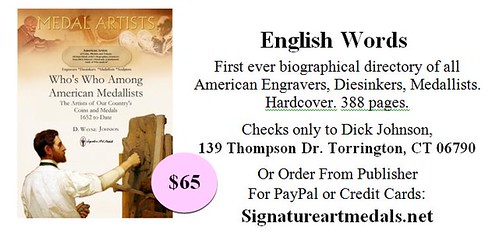
CANADA'S POLYMER NOTES THWARTING COUNTERFEITERS
 Canada's plastic money is stumping counterfeiters. The RCMP estimate the number of fake bills passed on to retailers in 2015 dropped by
74 per cent compared with the previous year.
Canada's plastic money is stumping counterfeiters. The RCMP estimate the number of fake bills passed on to retailers in 2015 dropped by
74 per cent compared with the previous year.
That doesn't mean people have given up trying to copy Canada's banknotes — it's just that even their best attempts to make fake cash are falling well short.
Regina Police Const. Scott Wolfe hasn't seen much counterfeit currency since the Bank of Canada introduced polymer money four years ago, but he did have a case last fall.
"When we first touched the bill you could tell it wasn't the polymer feel. It was paper. We could see they had cut out the security window from a real $5 bill and pasted it to a $50 and $100 bill," said Wolfe.
The face in the hologram didn't match the face on the bill and the edges were uneven. Even so, the money was successfully passed on to retailers, perhaps in a dimly lit bar or sandwiched between two authentic notes.
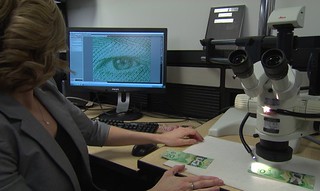 The bills in Wolfe's case, like all bills turned over to police across Canada, eventually end up at the RCMP's National
Anti-Counterfeiting Bureau in Ottawa. CBC News was granted exclusive access to the facility that examines counterfeit money, credit cards and
official documents such as passports and driver's licences.
The bills in Wolfe's case, like all bills turned over to police across Canada, eventually end up at the RCMP's National
Anti-Counterfeiting Bureau in Ottawa. CBC News was granted exclusive access to the facility that examines counterfeit money, credit cards and
official documents such as passports and driver's licences.
"Generally we're seeing a poor to medium-quality counterfeit note," said Robert Moyes, examiner of counterfeit for the RCMP.
About 10 years ago, when counterfeiting was at its height in Canada, Moyes said, his lab would receive up to 45,000 notes every month. In December, Moyes said, the lab received 1,500 bills and many were copies of older-series paper notes, which are easier to fake.
"It's more of a challenge to the counterfeiter to produce these [new banknotes] and the simulation of the security features has been very poor," said Moyes.
Most of the counterfeit polymer bills are printed on paper. Some used paper with a waxy or plastic coating. A few bills look passable from a distance, but up close are too shiny and slippery.
Several $5 bills at the bureau feature strips of glittery wrapping paper taped to transparent plastic strips in a crude attempt to simulate security holograms. Moyes said others go a step further by buying holographic sheets from shops in China. Shipments of the holographic sheets have even been seized by the Canada Border Services Agency.
All of the bills received by the bureau are examined by specialists under microscopes and different sources of light.
When a technician puts a genuine $50 bill under a high-powered microscope, the image of an eyeball comes up on a large computer screen. It's easy to see several security features, including the fine detail of raised red ink from an engraved plate. Even though that feature can only be seen under a microscope, it's something you can feel under your fingertips or by running a fingernail across the bill.
"It's got life to it. There's a tactility," Moyes said, adding that just the "feel" of a bill is one of the best ways a regular person can detect a fake.
When the genuine $50 bill is replaced under the microscope with a fake, it appears muddy on the screen.
"This is the eyeball — you can see the lack of line work, resolution. And in some cases, if it's toner, it flakes right off," Moyes points out.
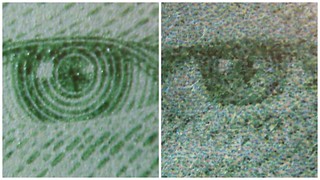
To read the complete article, see:
Counterfeiters perplexed by
Canada's plastic money (www.cbc.ca/news/politics/counterfeiters-perplexed-by-canada-s-plastic-money-1.3401839)
FANS WANT DAVID BOWIE ON A U.K. BANKNOTE
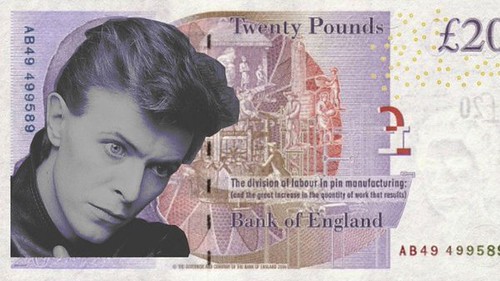
David Bowie fans are calling on the UK Government to honour the late star on an official banknote.
Bowie died on Sunday (January 10) at the age of 69, with reports suggesting that he had been suffering from liver cancer for 18 months.
Following his death, tributes have flooded in from political figures such as David Cameron and Jeremy Corbyn, with Cameron tweeting: "I grew up listening to and watching the pop genius David Bowie. He was a master of re-invention, who kept getting it right. A huge loss".
Now a petition has been launched with the aim of getting Bowie's face on the new £20 note, with over 12,000 fans backing the cause. A new £20 banknote is set to be launched in the Spring with no decision as to who will appear on the note currently announced. Economist Adam Smith appears on the current £20 note.
To read the complete article, see:
Petition to get David Bowie's face on new £20 note passes 12,000 signatures
(www.nme.com/news/david-bowie/90791)
ARGENTINA TO ISSUE HIGHER DENOMINATION BANKNOTES
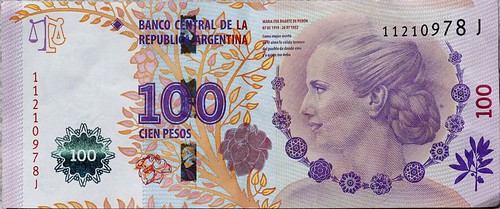
Argentina's Central Bank said on Friday it would issue higher denomination banknotes this year and next, in the face of double-digit inflation that has gnawed away at the value of the local currency.
The largest bank note in Latin America's third biggest economy is the 100 peso bill, currently worth $7.4 U.S. dollars. Cash machines often run out of money over long weekends because they cannot contain enough bills to satisfy demand.
From mid-year, the Central Bank will start circulating 200 peso and 500 peso bank notes, and next year will introduce the 1,000 peso note.
"The incorporation of bills of higher denomination is a practical necessity for the better functioning of cash machines and the reduction of the cost of moving cash around," the bank said in a statement.
The Central Bank said the new banknotes would be printed with images of the country's indigenous animals.
To read the complete article, see:
Inflation-stricken Argentina to issue higher denomination
banknotes (www.reuters.com/article/us-argentina-economy-idUSKCN0UU00J)
To read the complete article, see:
Argentina's Approach To Inflation: Ditch The
Peso, Hoard U.S. Dollars (http://kccu.org/post/argentinas-approach-inflation-ditch-peso-hoard-us-dollars)
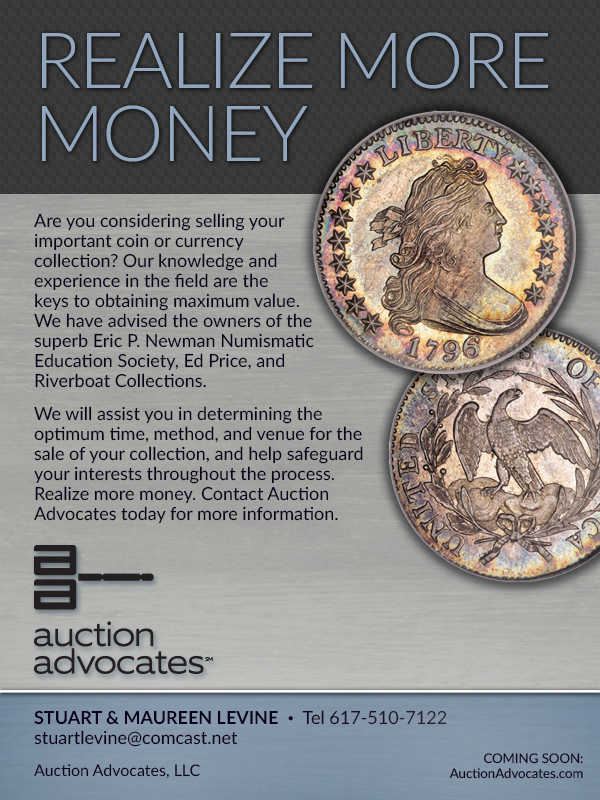
BANKS REFUSE TO HANDLE CHINESE MAN'S COIN STASH
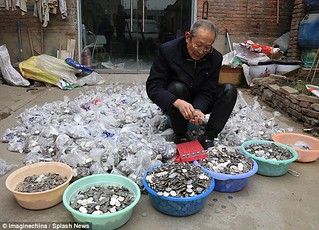 One plucky businessman has been left with the difficulty of trying to convert the hundreds of thousands of coins he has accumulated into
cash notes and bank credit.
One plucky businessman has been left with the difficulty of trying to convert the hundreds of thousands of coins he has accumulated into
cash notes and bank credit.
The laundry business owner surnamed Zhang, from Zhengzhou in central China's Henan province, revealed that he had piled up coins worth over 300,000 yuan (£32,000) over a couple of months, according to a report by People's Daily Online.
The coins, which weigh around 1.5 tonnes, have been stored at Mr Zhang's warehouse in plastic bags, with 500 one Yuan coins per bag.
After going round the Agricultural Bank of China, the Construction Bank of China and Minsheng Bank, he was told he could only convert 2,000-3,000 coins a day, amounting to an extremely slow and time wasting process.
Mr Zhang called for help to local newspapers on January 11 saying he was in desperate need of changing these coins to banknotes so he can pay salary to his staff.
He told assembled reporters: ‘I’m extremely concerned about my many coins. If any supermarkets need small change, please contact me.’
To read the complete article, see:
Too much money CAN be a headache! Entrepreneur pleads for help after banks refuse to accept the 1.5 tonnes of coins he earned from laundry
business
(www.dailymail.co.uk/news/peoplesdaily/article-3395474/Chinese-laundry-entrepreneur-pleads-help-banks-refuse-accept-1-5-tonnes-coins.html)
CHINESE MAN BUYS CAR WITH LOW-VALUE BANKNOTE HOARD
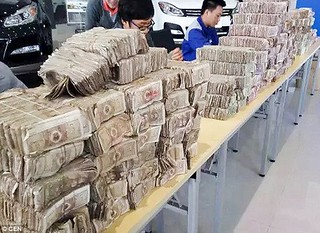 A Chinese businessman managed to cause anguish to the employees of a local car dealership by turning up with 80 stone worth of loose
banknotes and attempting to pay for a new vehicle.
A Chinese businessman managed to cause anguish to the employees of a local car dealership by turning up with 80 stone worth of loose
banknotes and attempting to pay for a new vehicle.
Staff at the showroom in Zhanjian city, Guangdong Province, south China, were stunned yesterday when Mr Cai tried to buy his new car with huge boxes filled with rolled notes, according to Huanqiu.com, an affiliation to People's Daily.
Mr Cai, as it turned out, is a food wholesaler at the city's Haitian market whose business is entirely cash-based - leaving him with thousands in cash and not so much in the bank.
Gu Liyuan, manager at the depot, said he was tempted to turn away the customer after he refused to pay by card and credit and insisted he could only purchase the £8,000 car with 1 RMB (10p) and 10 cent RMB (1p) notes.
He told reporters: 'I've never seen so much money in my life', adding that the depot 'smelt like money' after Mr Cai had dragged in his currency boxes.
Meanwhile Mr Cai admitted that he had a problem in the past with banks not accepting his cash.
He said: 'I receive loose change amounting up to 10,000 Yuan every day and hundreds of thousands of Yuan every month.'
'Because I have too much loose change, many banks refuse to exchange for me or they treated me very coldly. I think about how to spend this money every day.'
To read the complete article, see:
All that'll take some counting: Chinese food wholesaler pays for his new £8,000 car with loose banknotes
(www.dailymail.co.uk/news/peoplesdaily/article-3395848/Chinese-customer-pays-new-8000-car-entirely-using-lowest-value-banknotes.html)
CHINESE MAN SHREDS $21,000 IN BANKNOTES
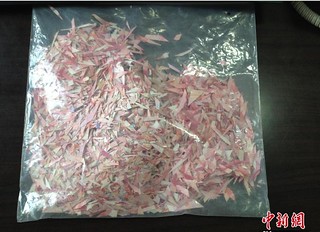
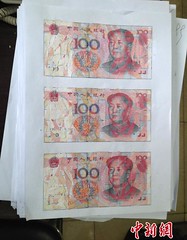
Grumpy old man shreds 140,000 yuan ($21,252) worth of banknotes into pieces.
The man's son and daughter-in-law spent three months putting together 108,000 yuan in Anshan, Northeast China's Liaoning province.
The son, surnamed Chen, said his father sold a house for 200,000 yuan last year and kept the money.
In October, father told Chen that he cut 140,000 yuan out of 200,000 yuan into pieces, in order to keep his greedy children away.
Chen was shocked and found each banknote was cut into dozens of pieces. Chen and his wife tried to repair the damage done by the father. The process took from 7 am to 12 am every day, from October to early January. In that time the couple fixed 1,080 banknotes.
Chen exchanged the damaged bank notes for new ones and deposited them with the remaining 60,000 yuan into his bank.
To read the complete article, see:
Son Puts Together Banknotes After Dad Shreds $21,000 into Pieces
(http://english.cri.cn/12394/2016/01/15/3561s912957.htm)
FEATURED WEB SITE: CENTRAL STATES NUMISMATIC SOCIETY
This week's Featured Web Site is the Central States Numismatic Society.The Central States Numismatic Society, founded in 1939, is one of the larger numismatic organizations in the United States with membership fluctuating around 2,000. CSNS, as it is known informally, operates in a 13 state Midwestern region but membership is open to residents of all states and foreign countries.
States in the region are Illinois, Indiana, Iowa, Kansas, Kentucky, Michigan, Minnesota, Missouri, Nebraska, North Dakota, Ohio, South Dakota and Wisconsin.
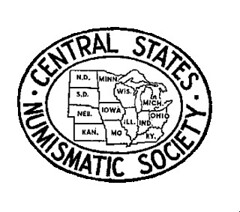
www.centralstates.info

